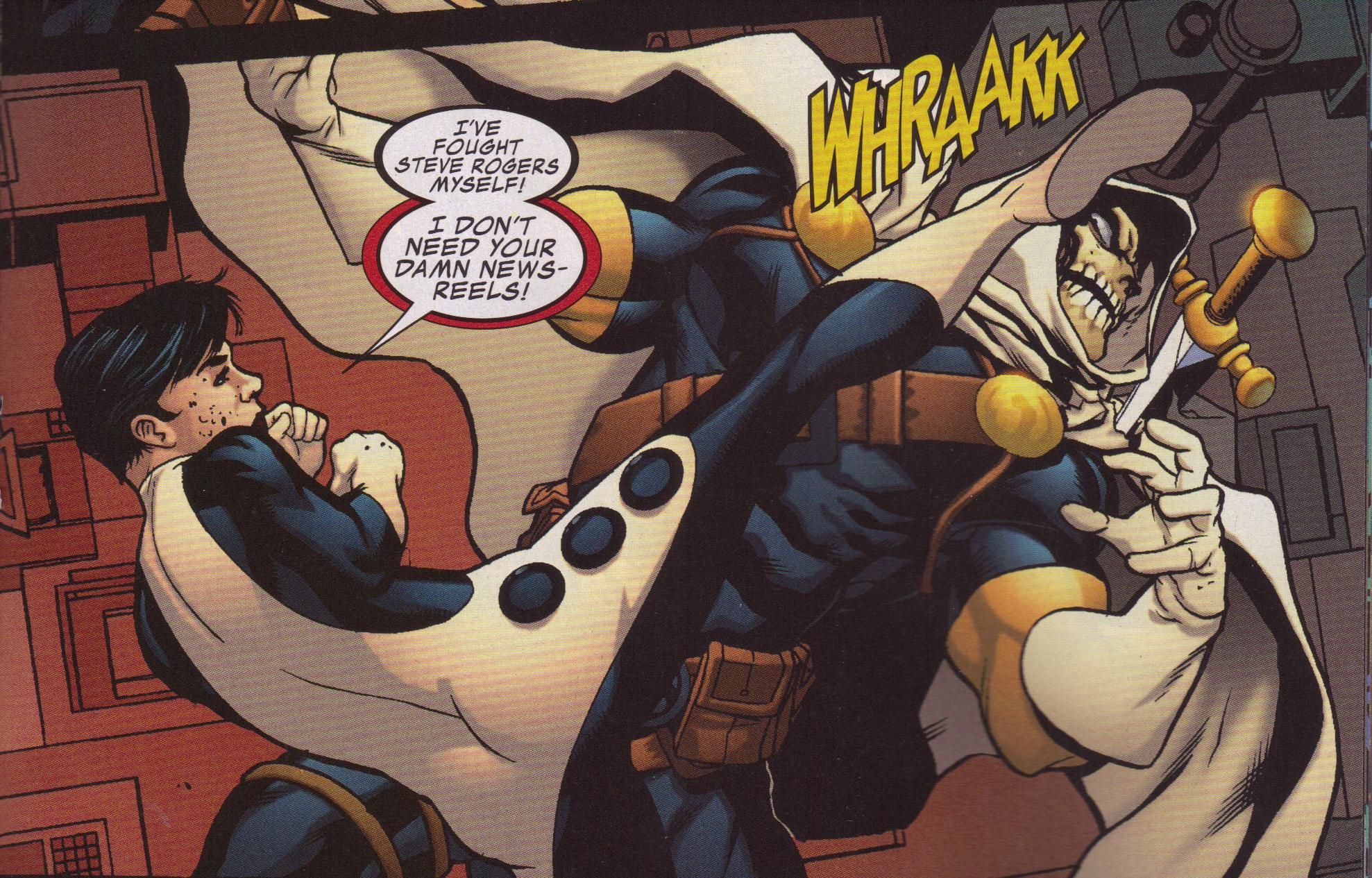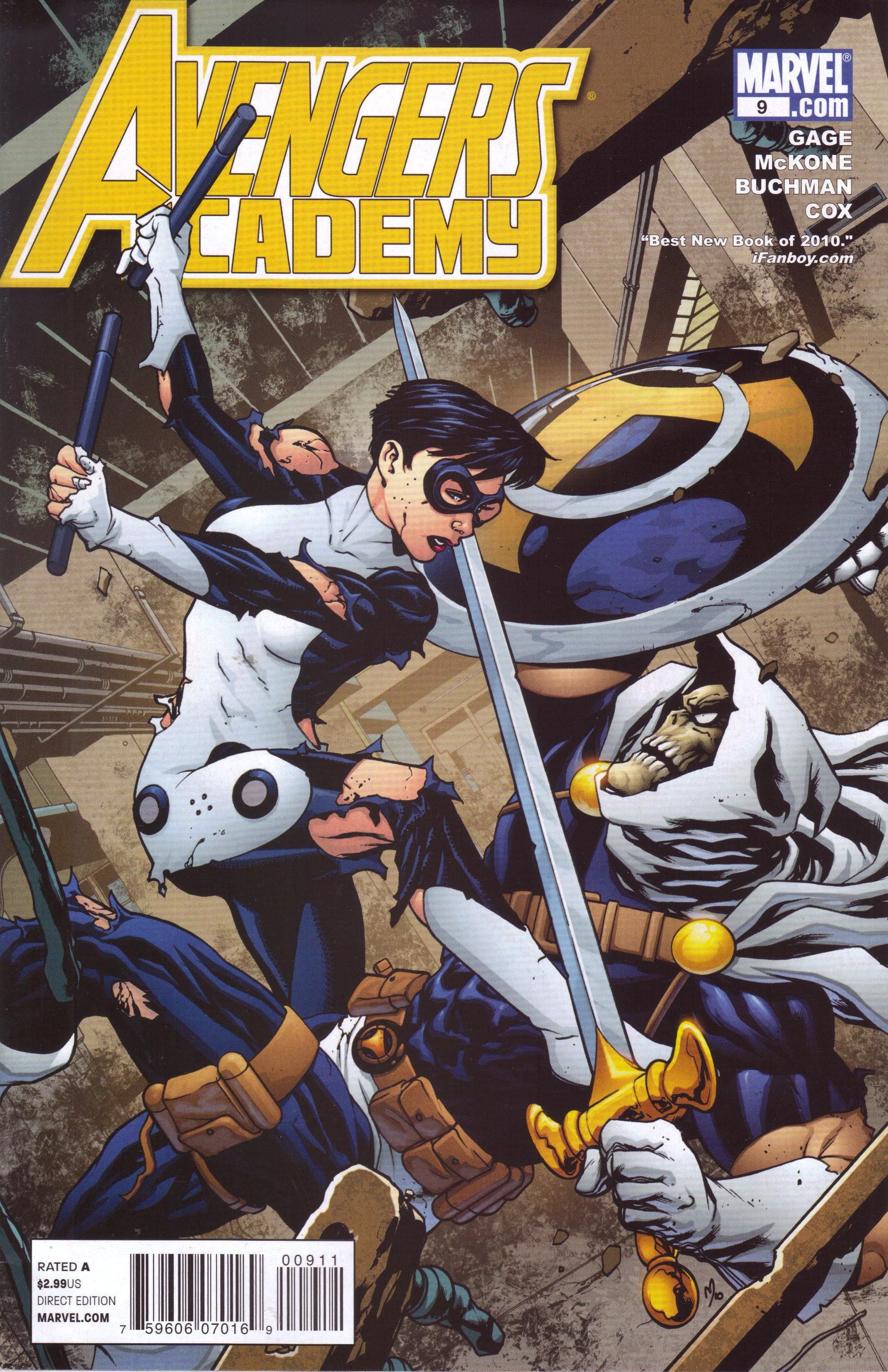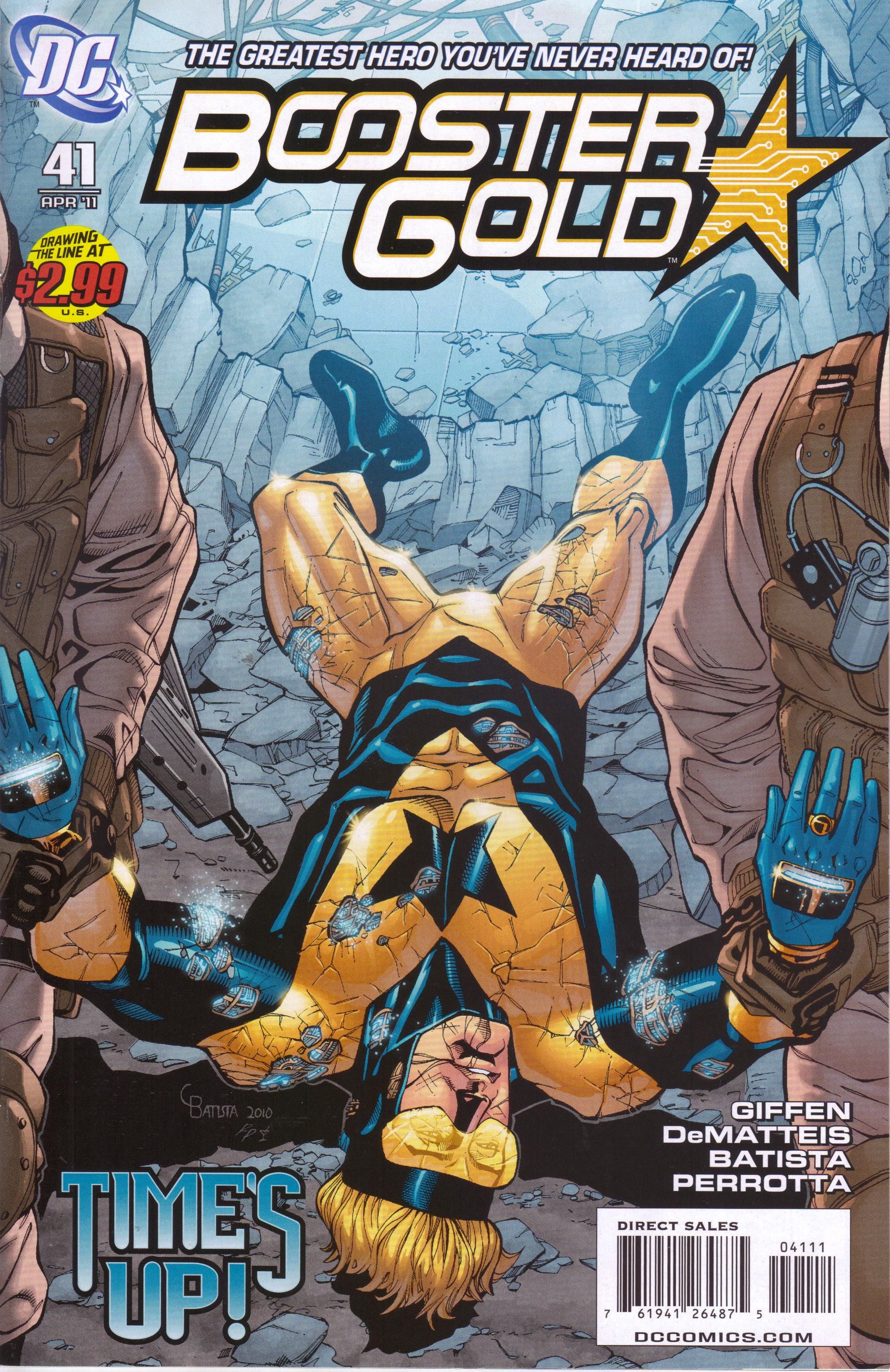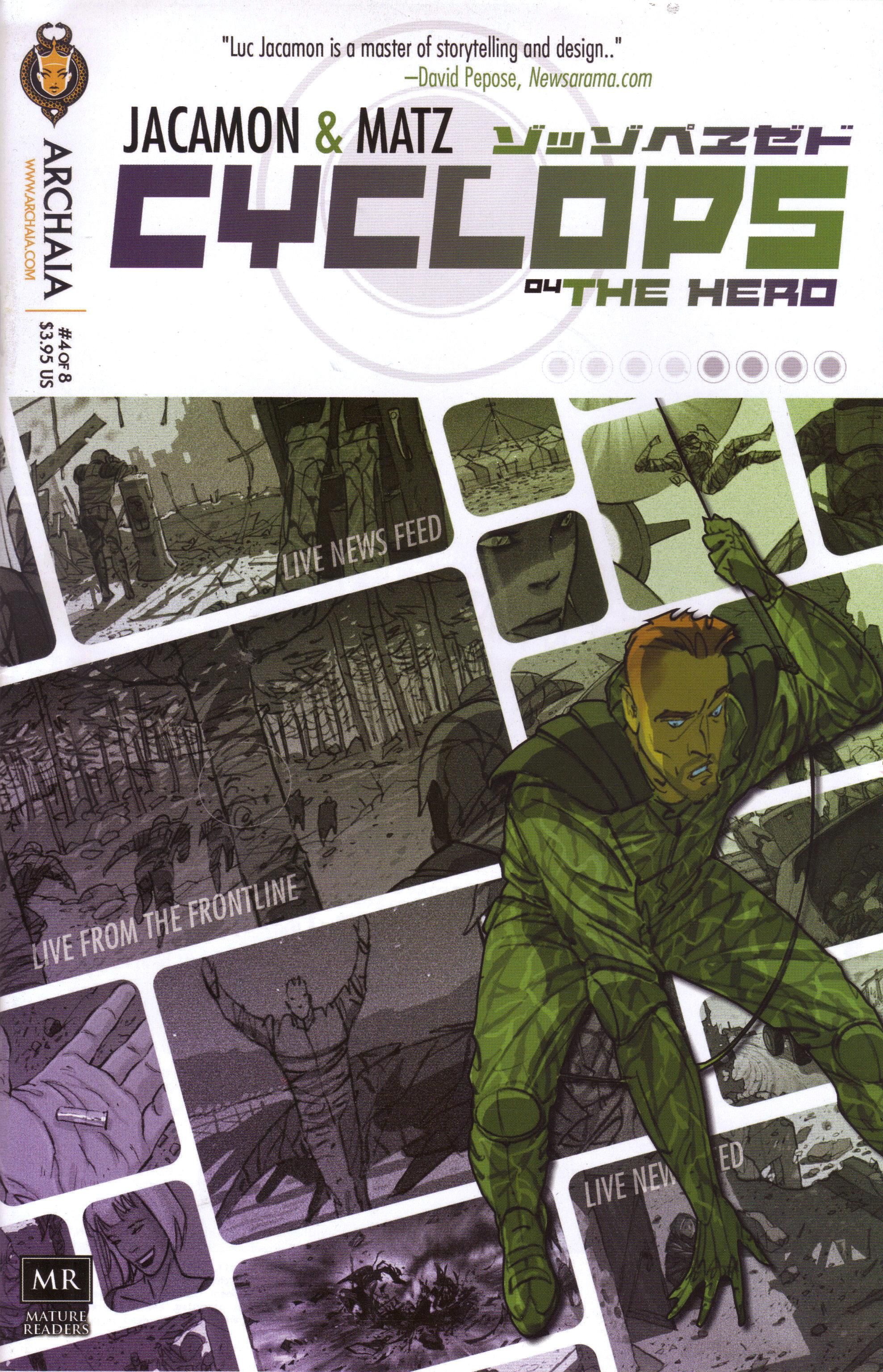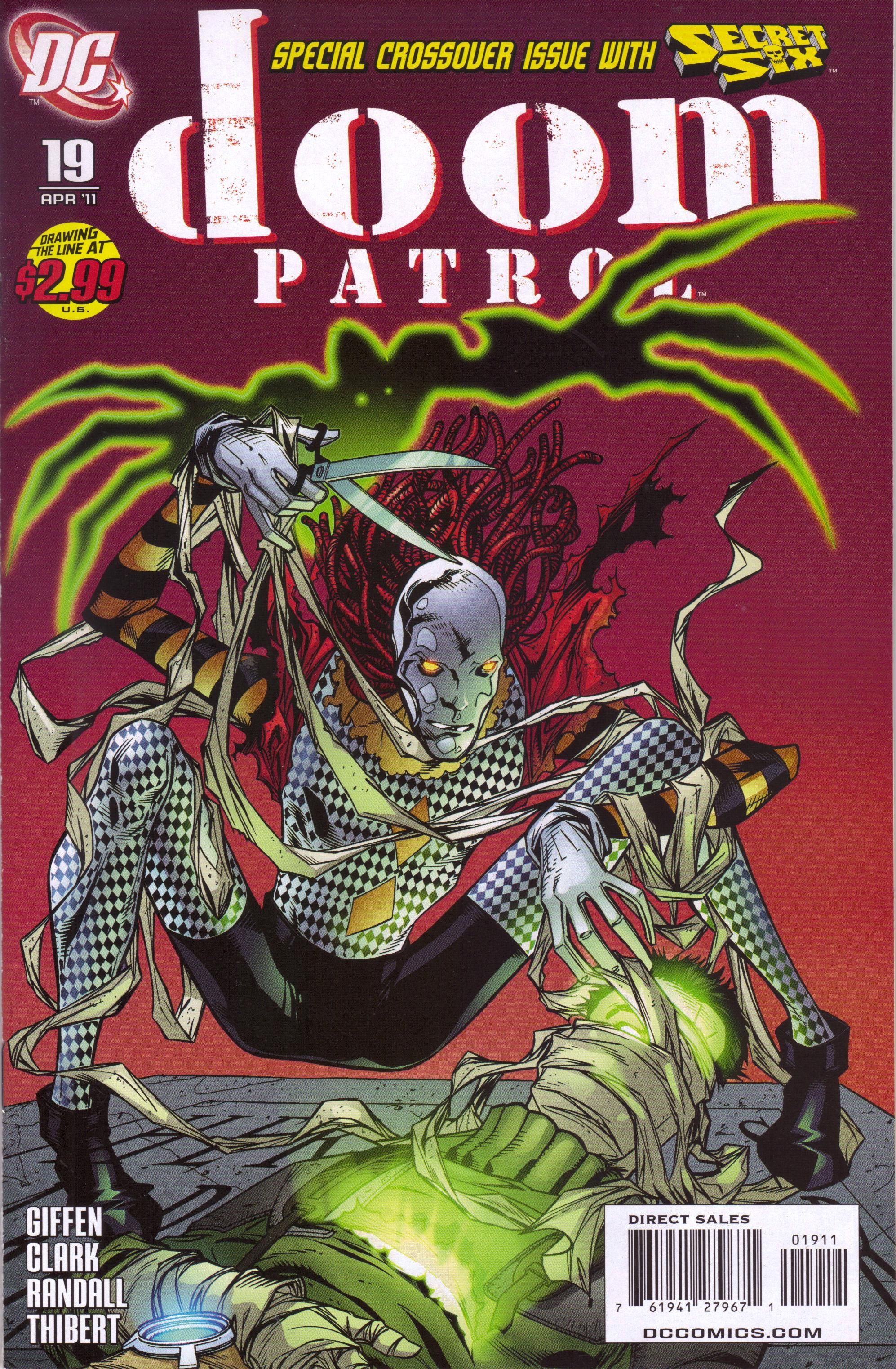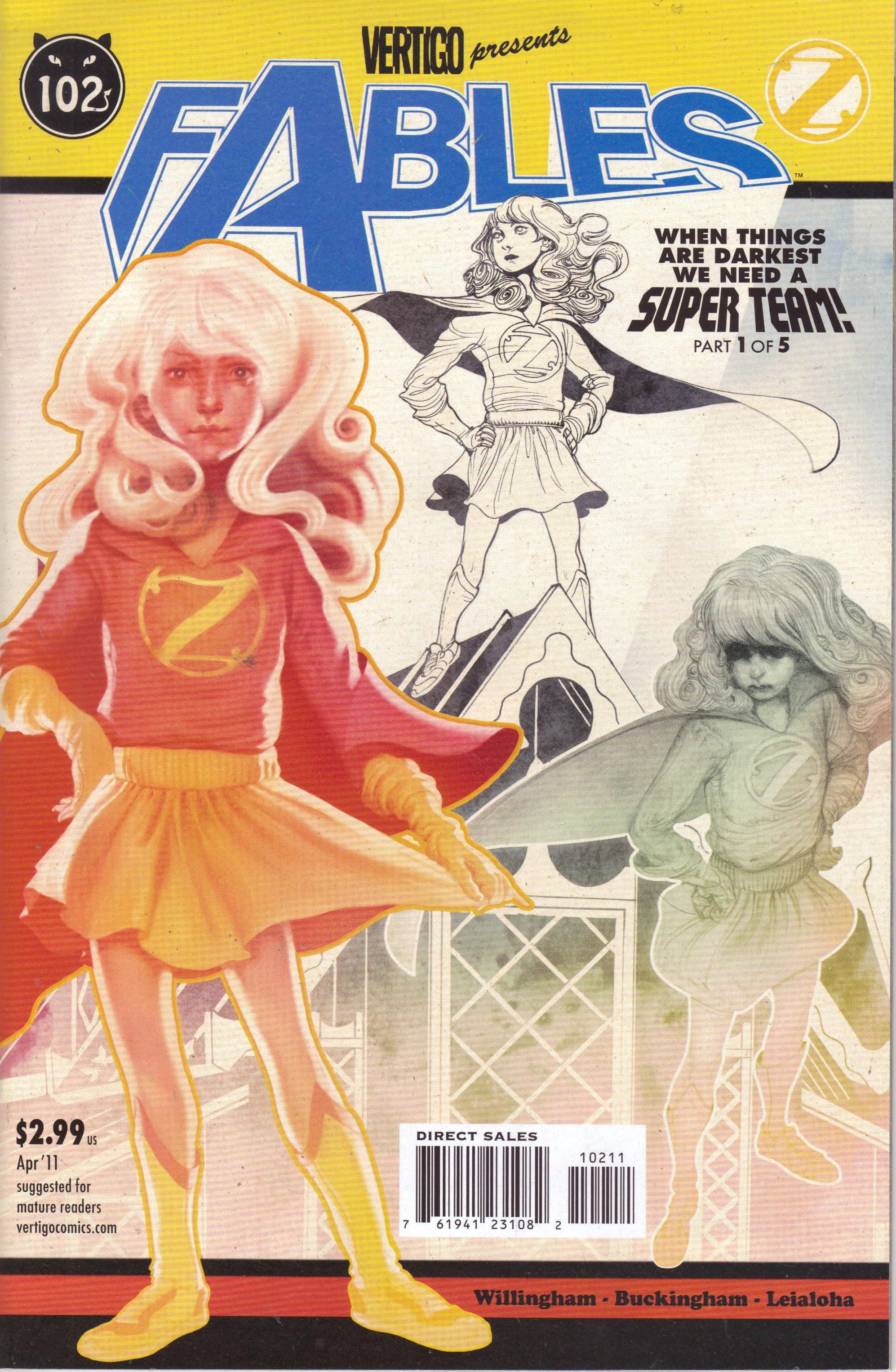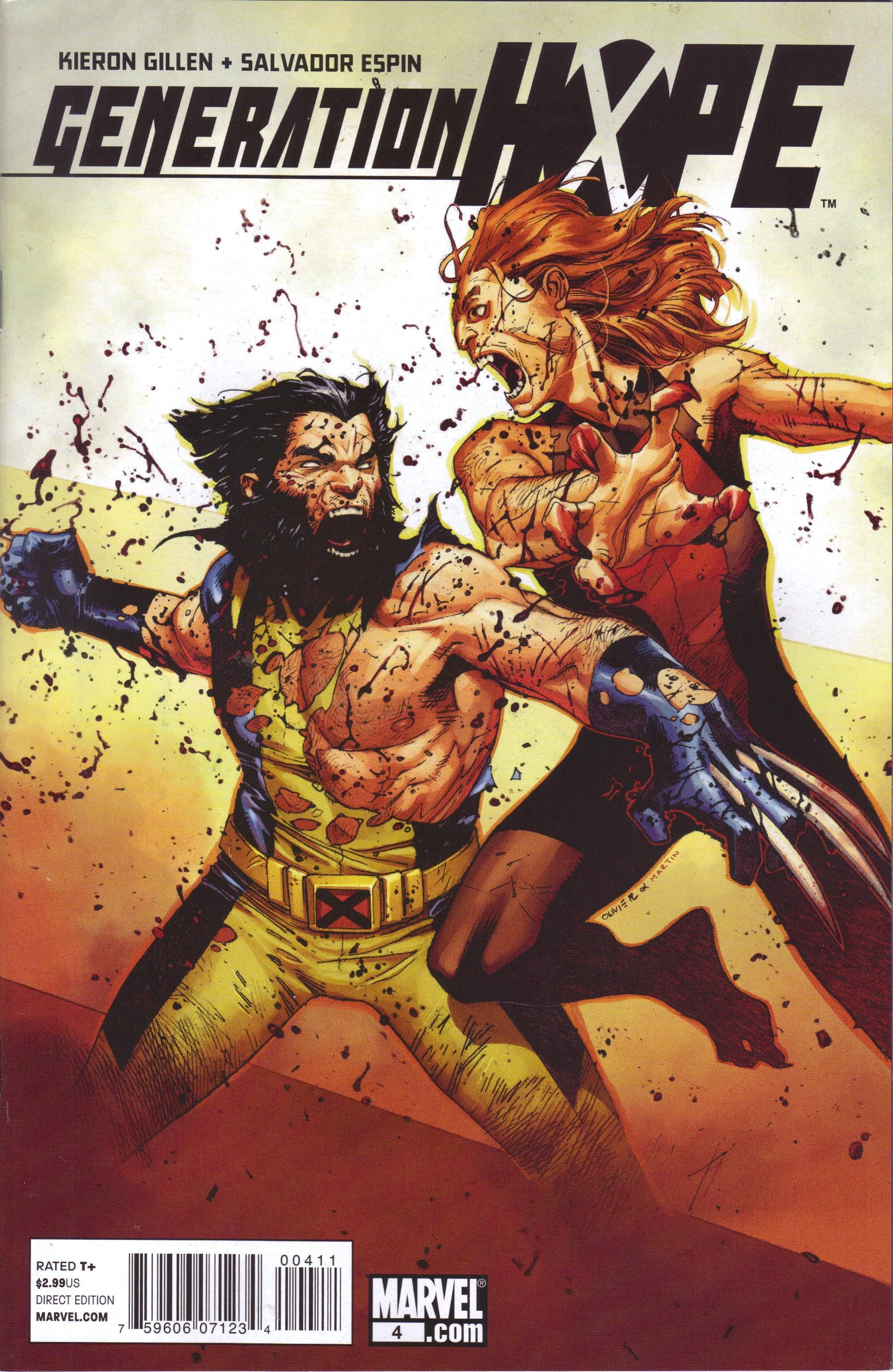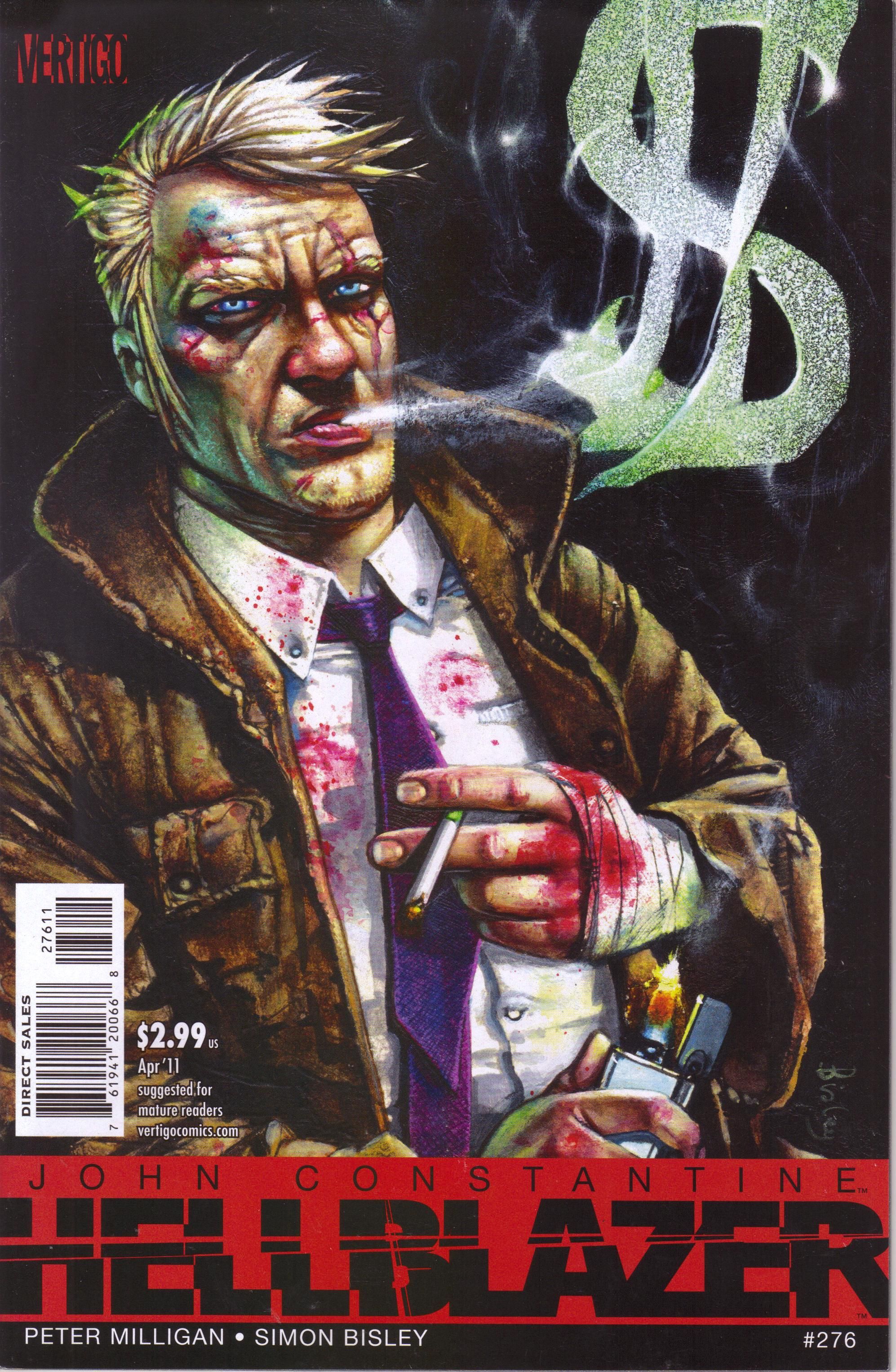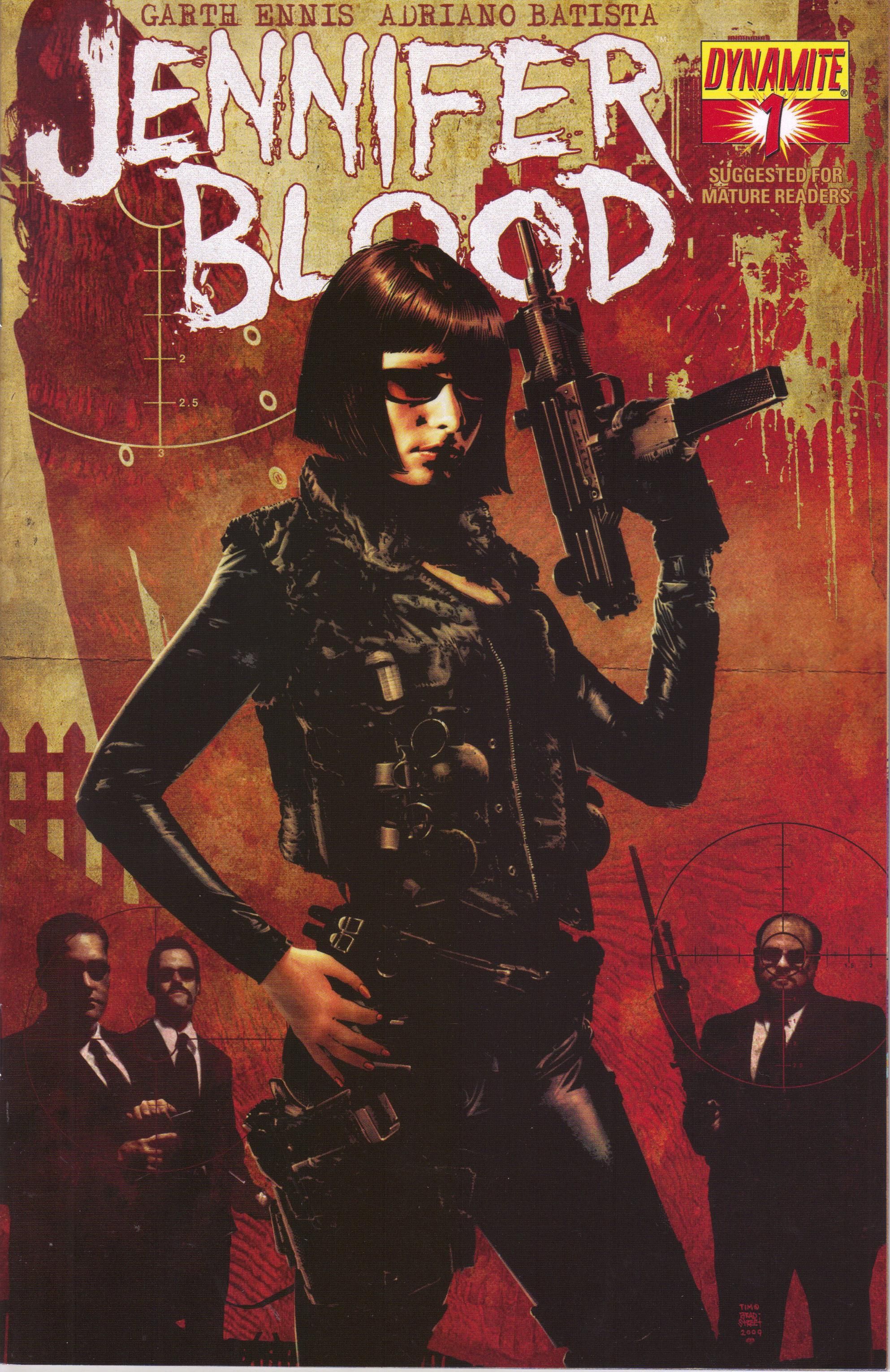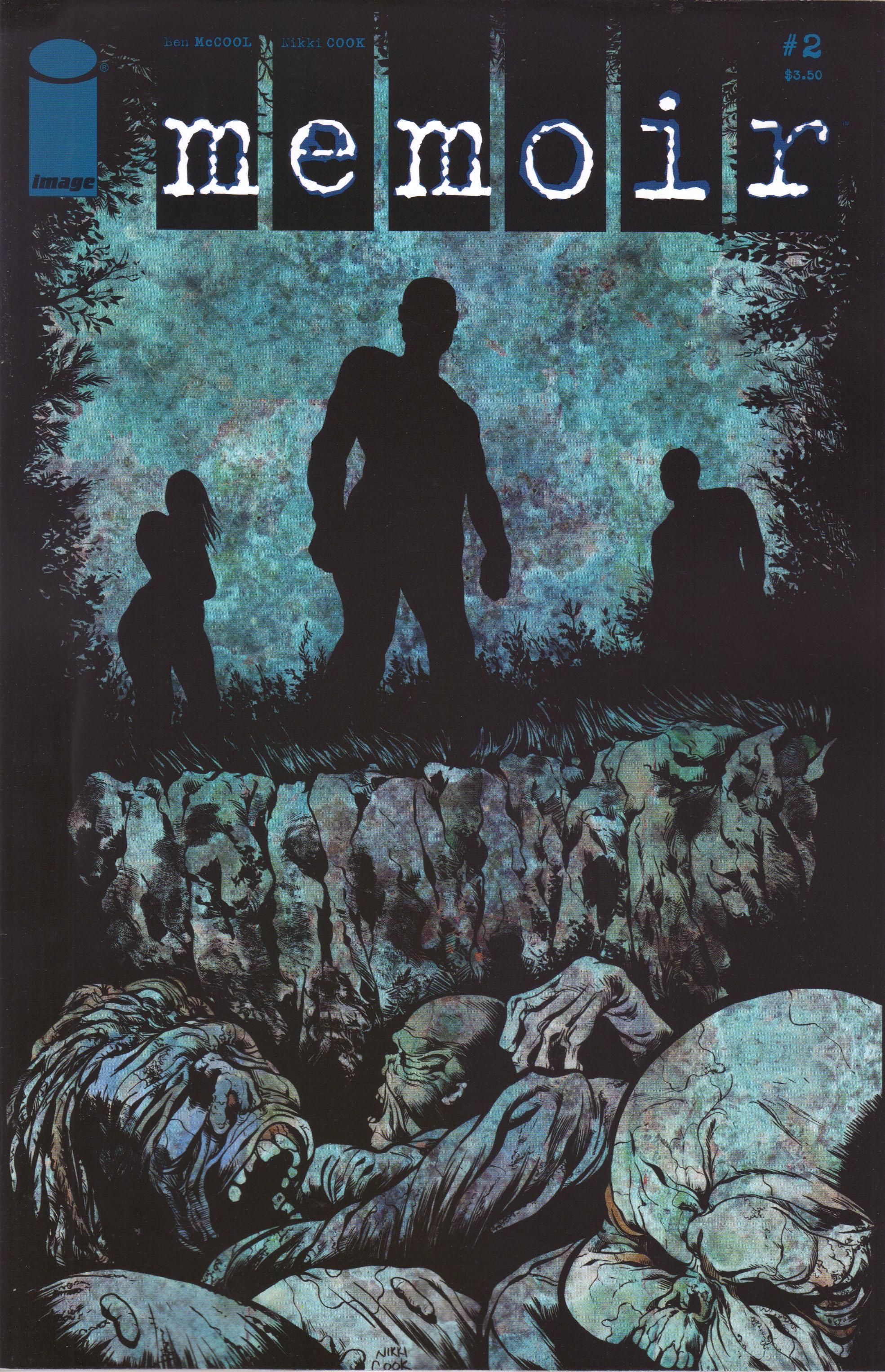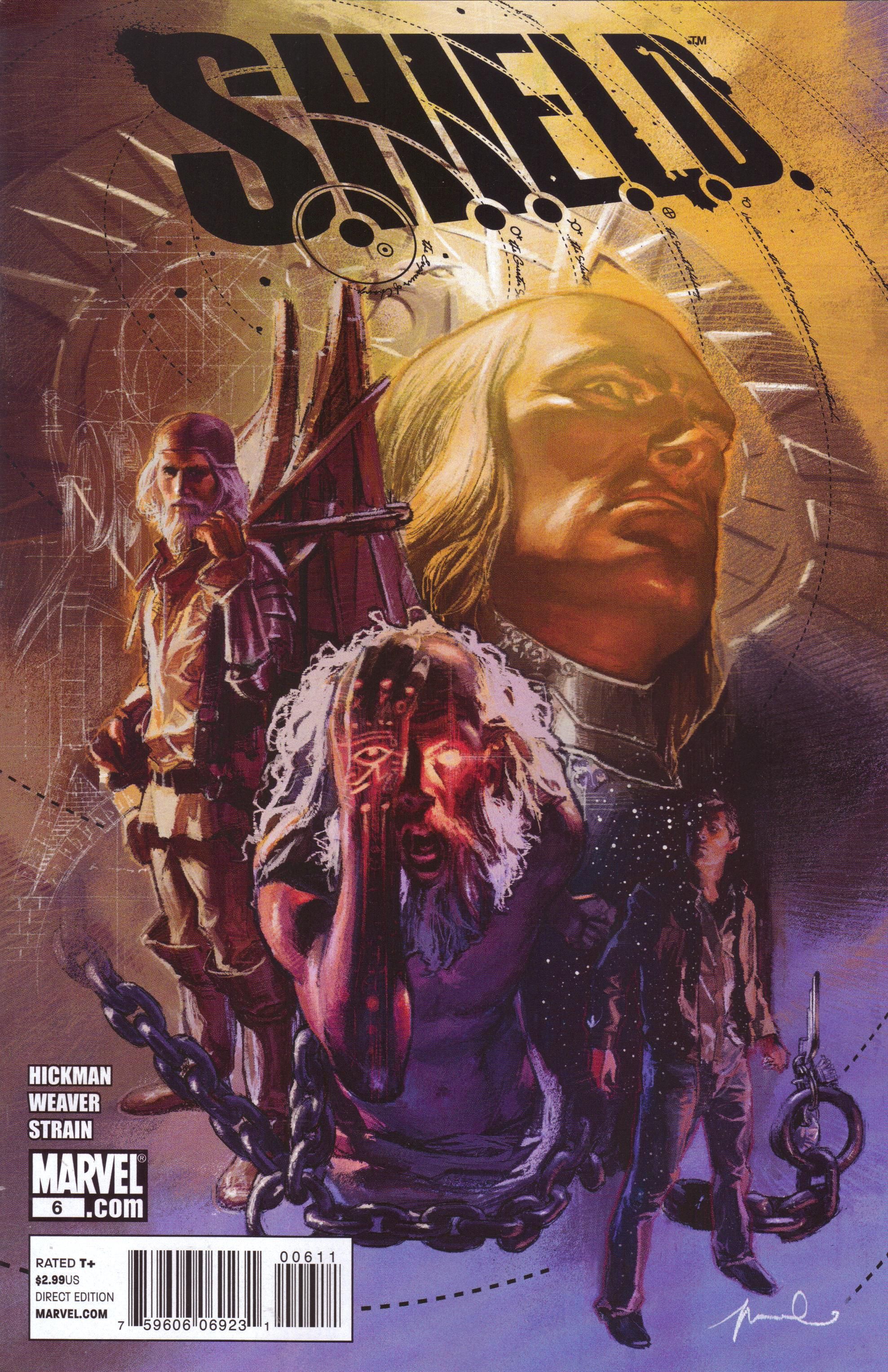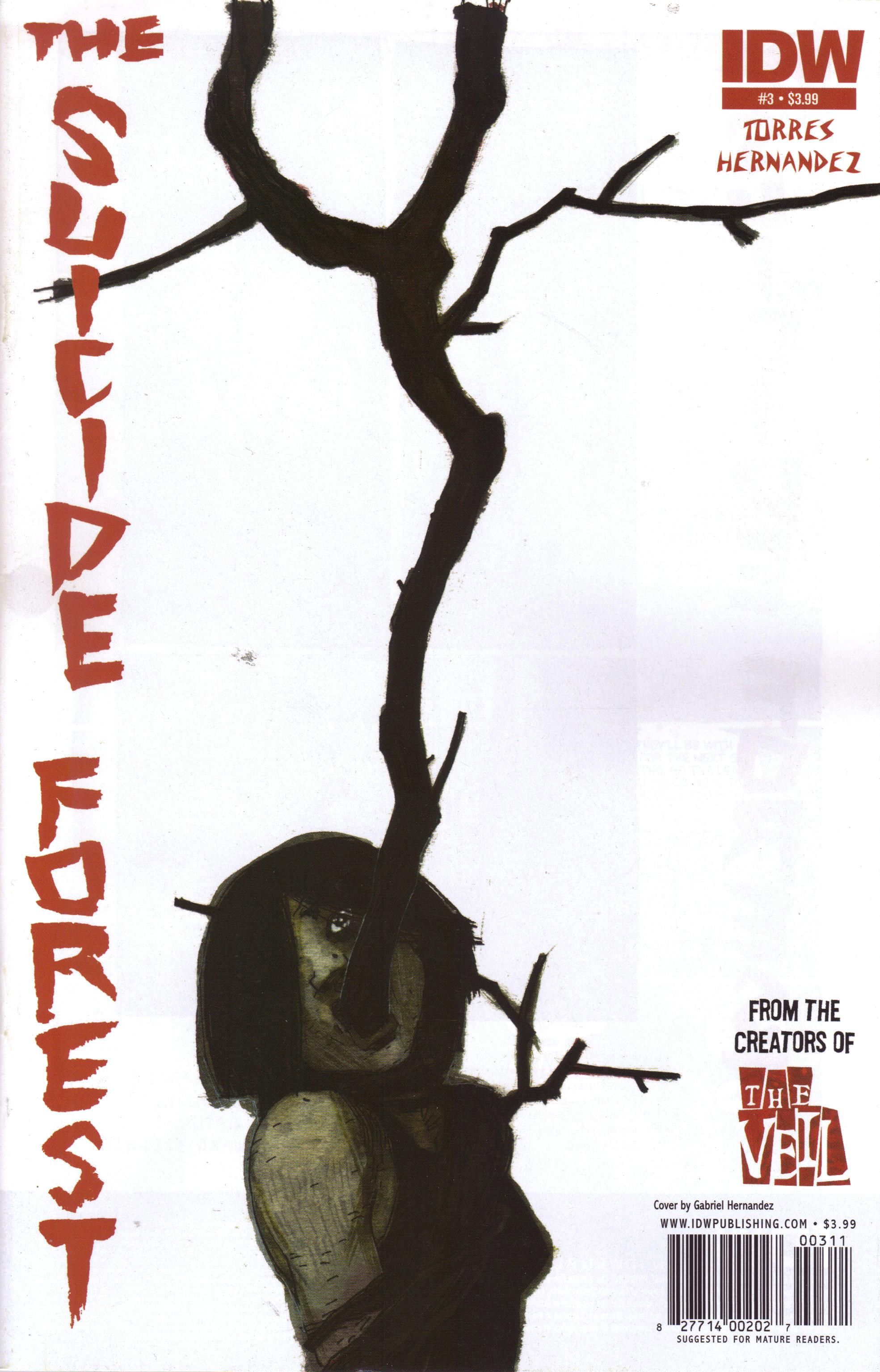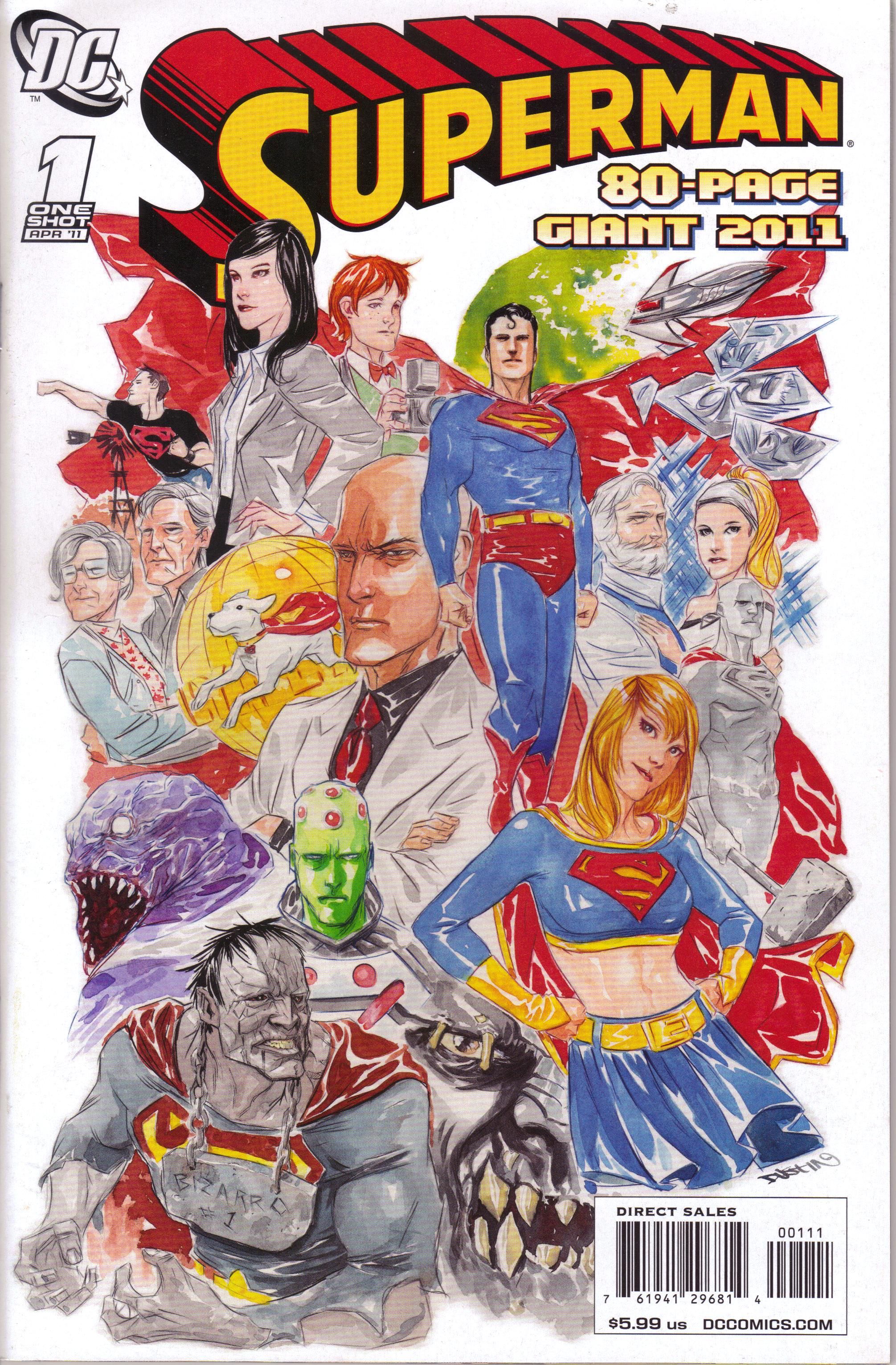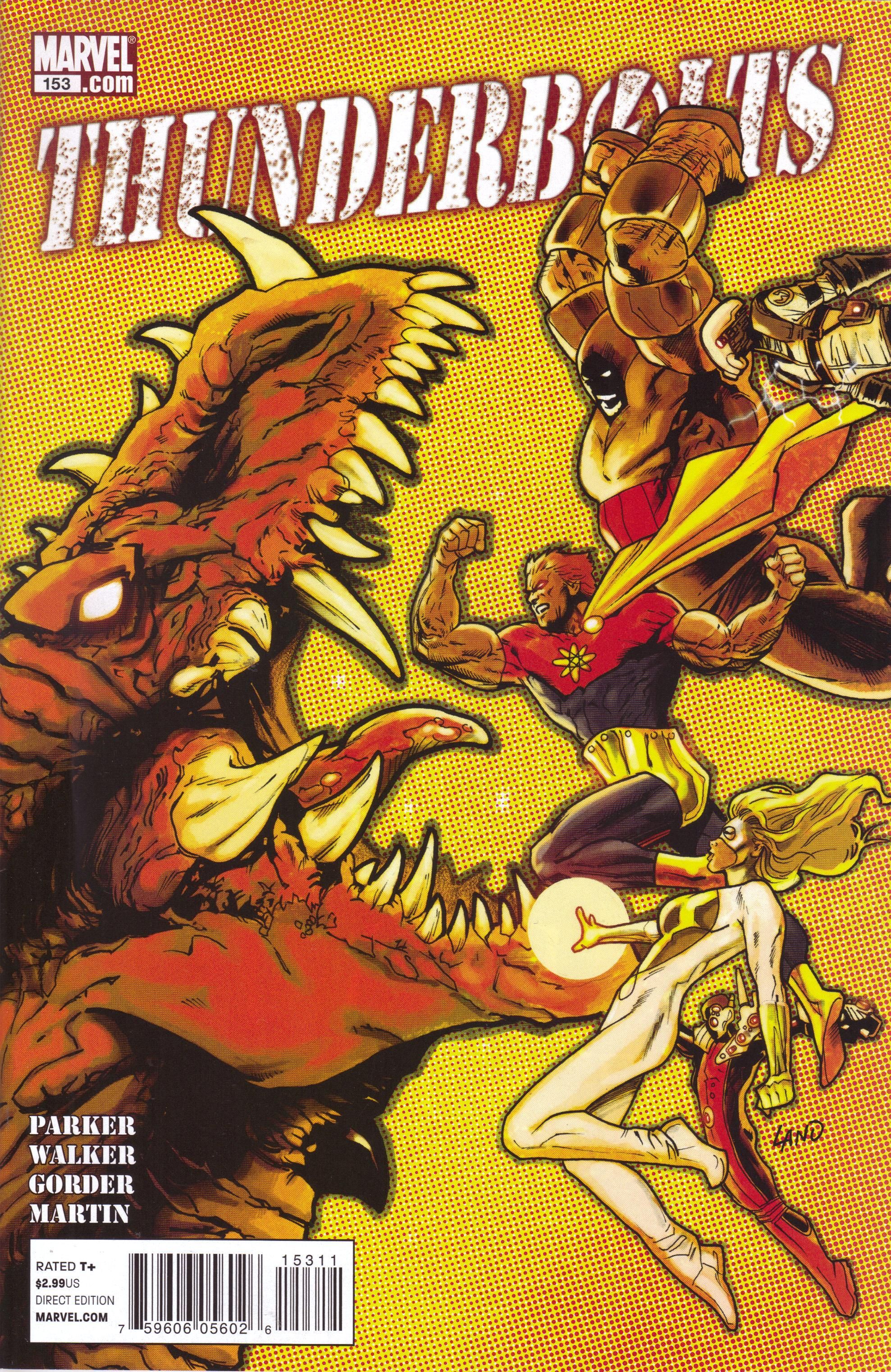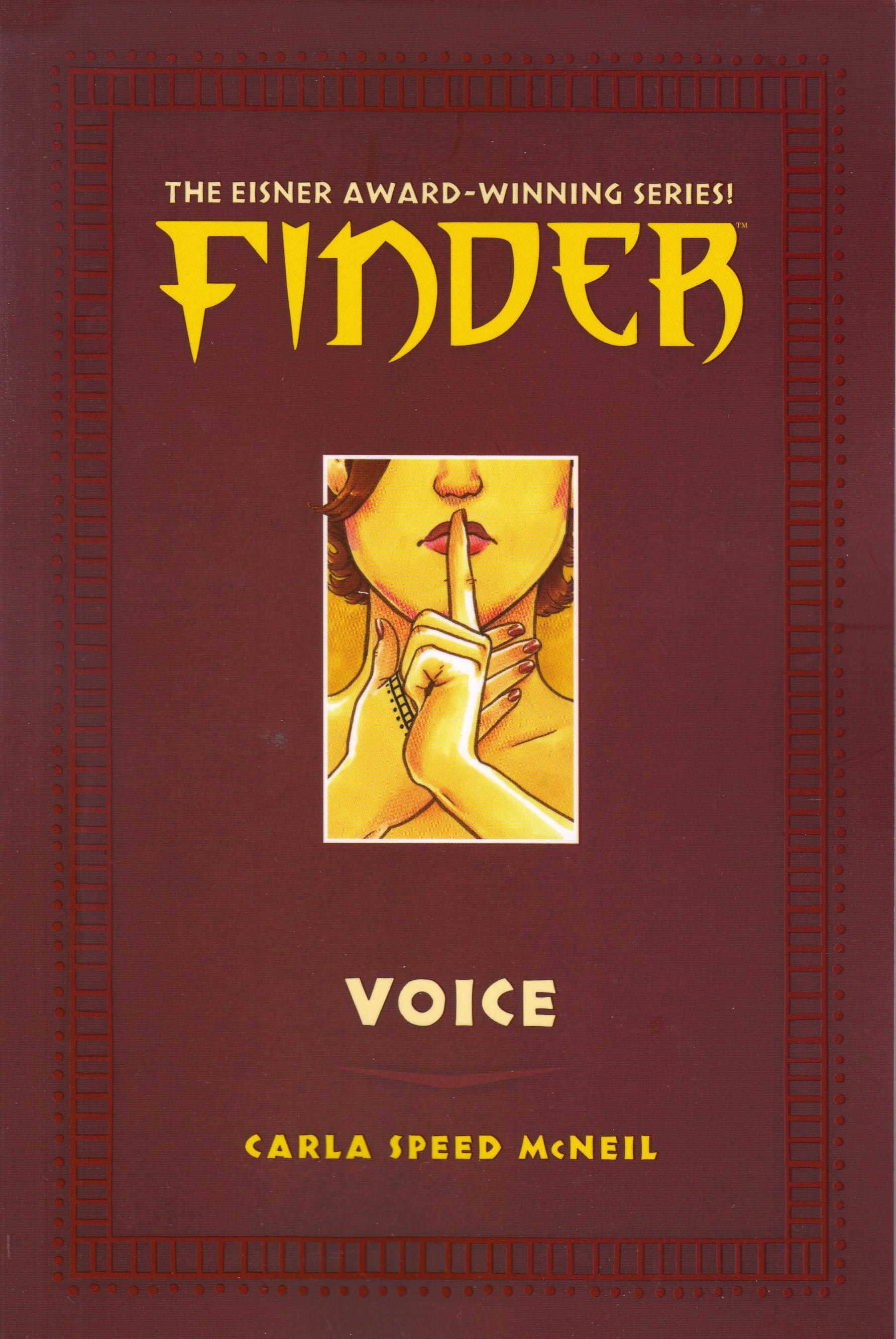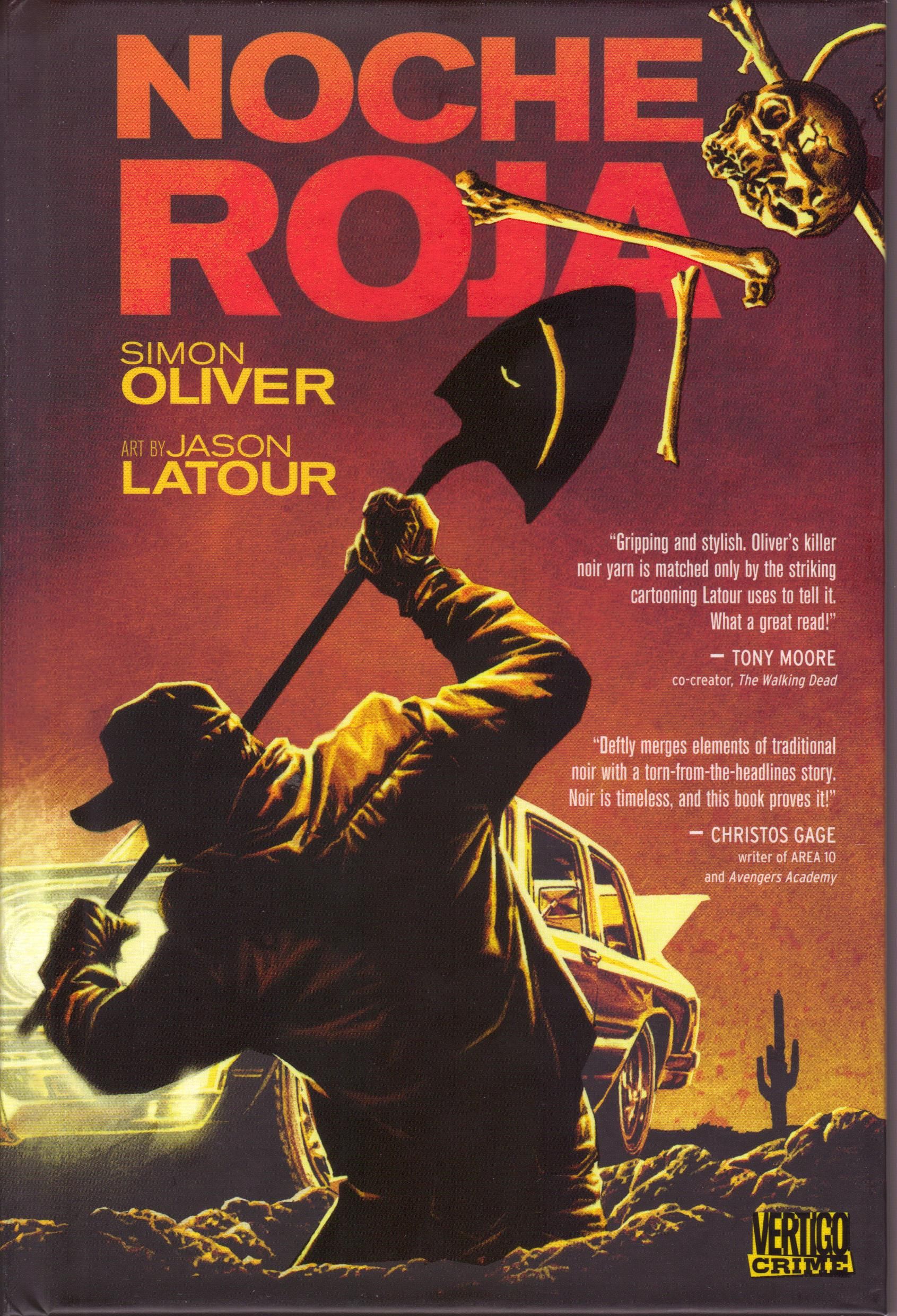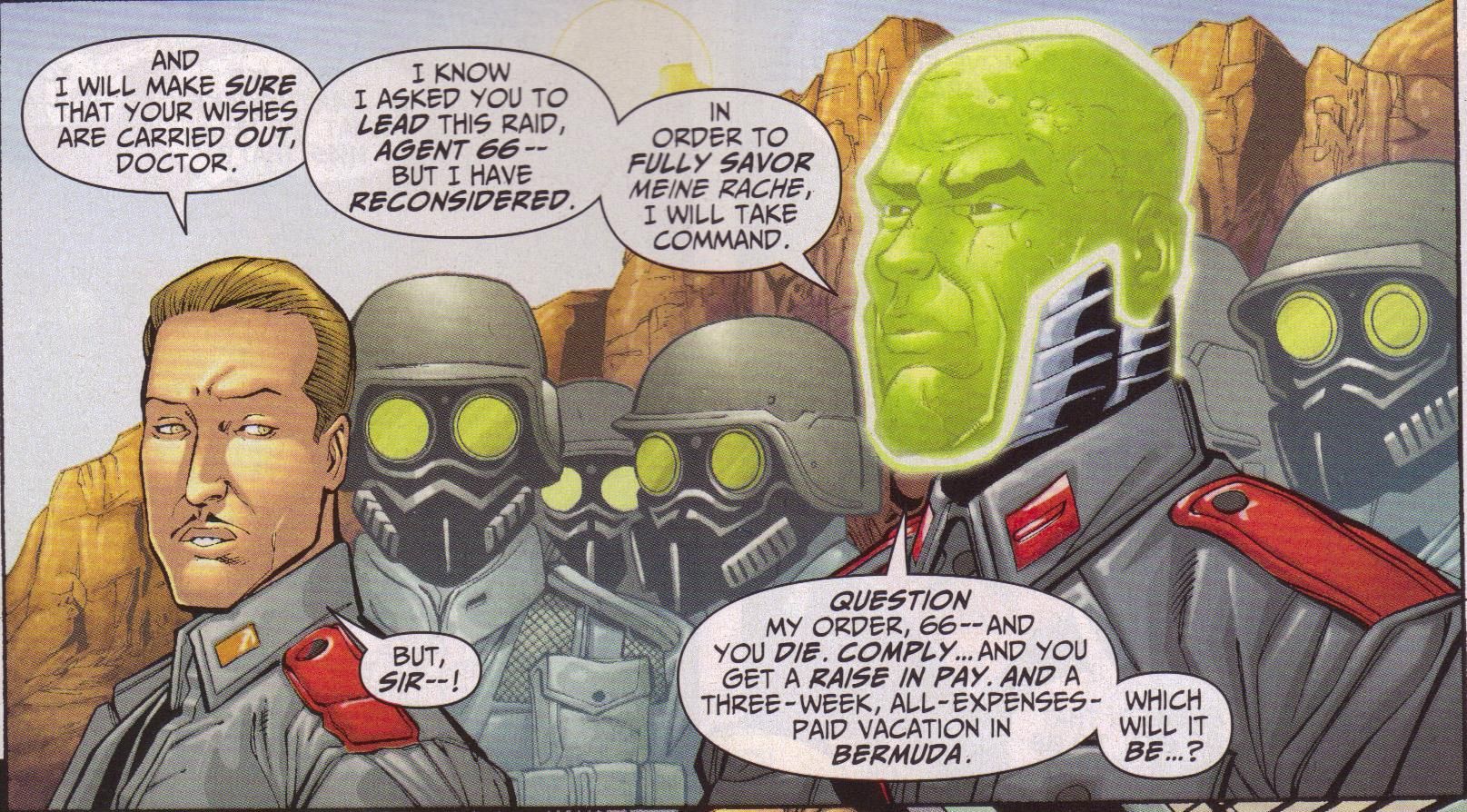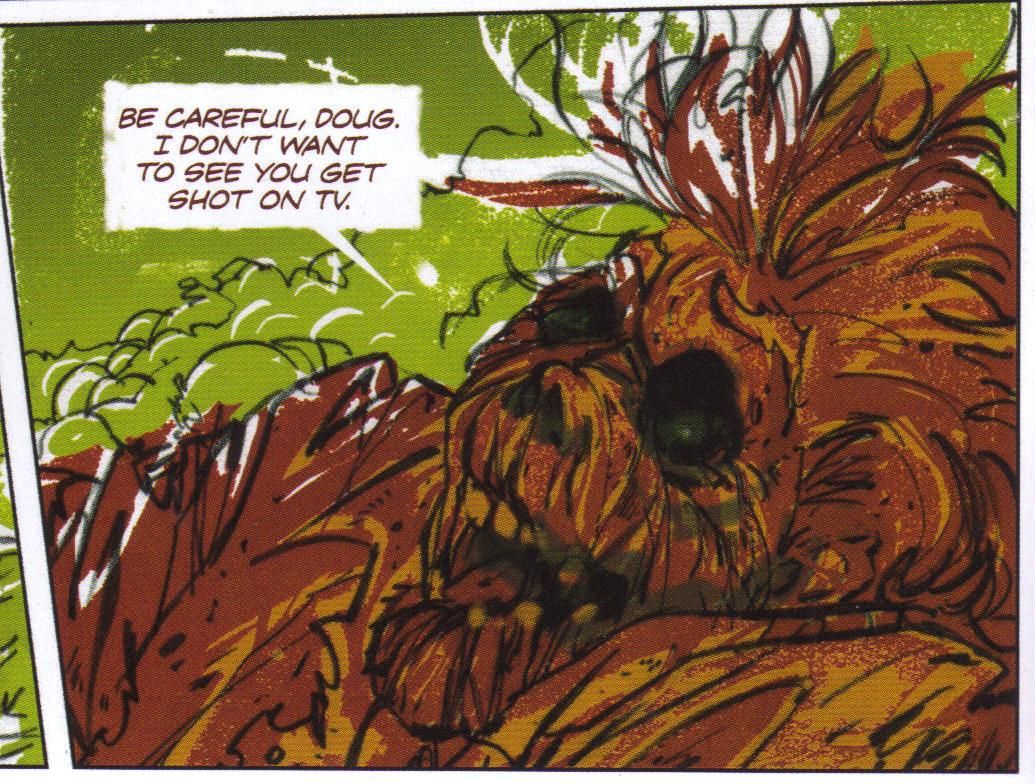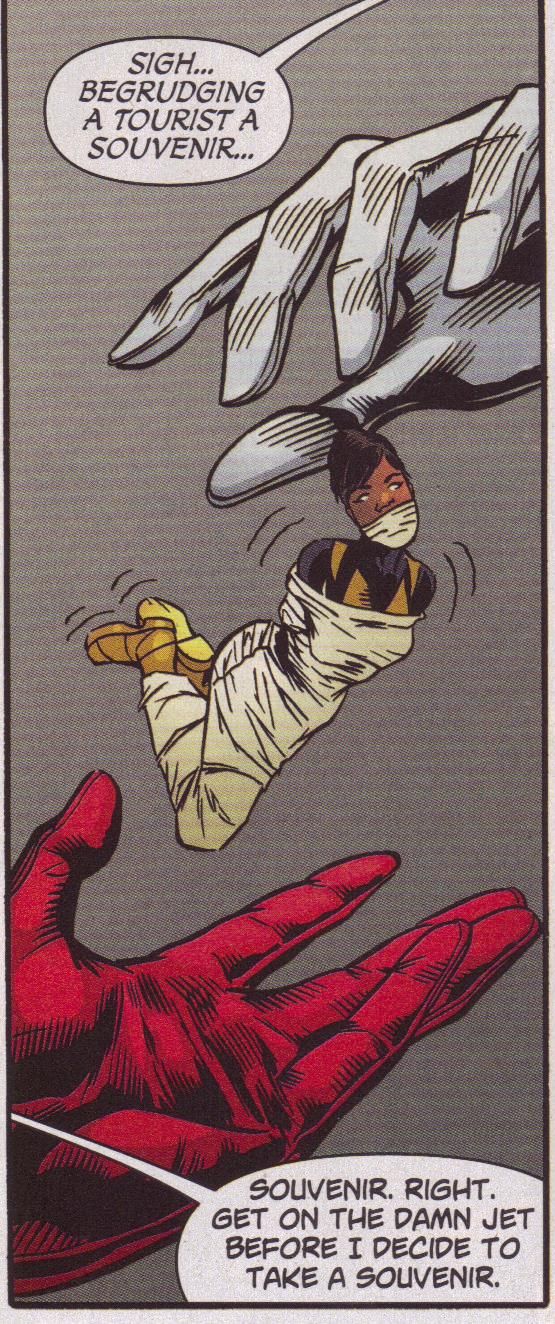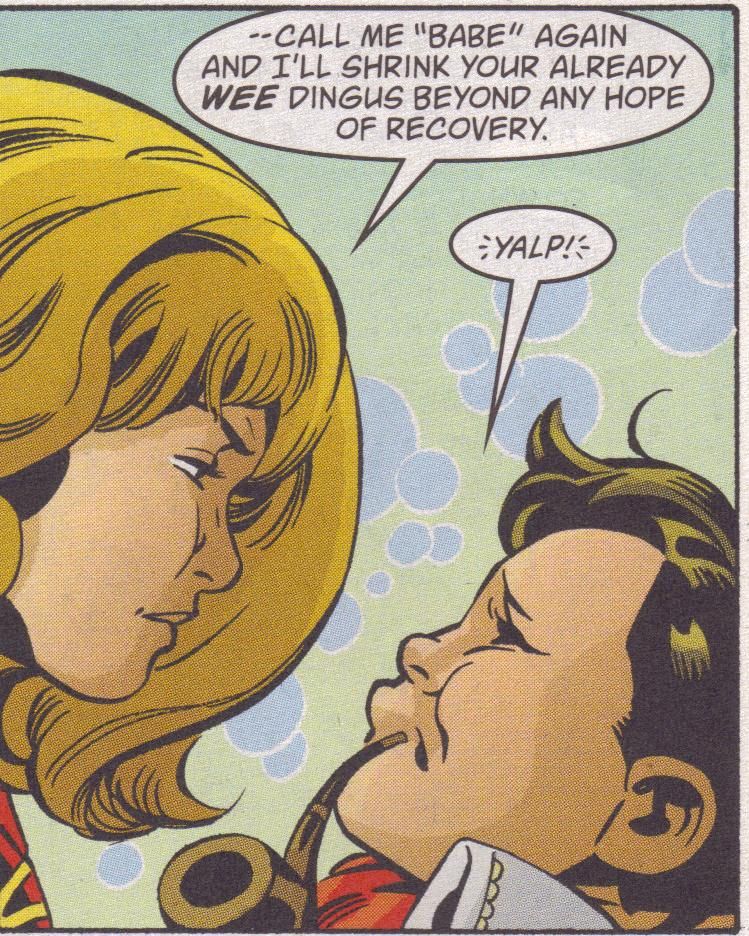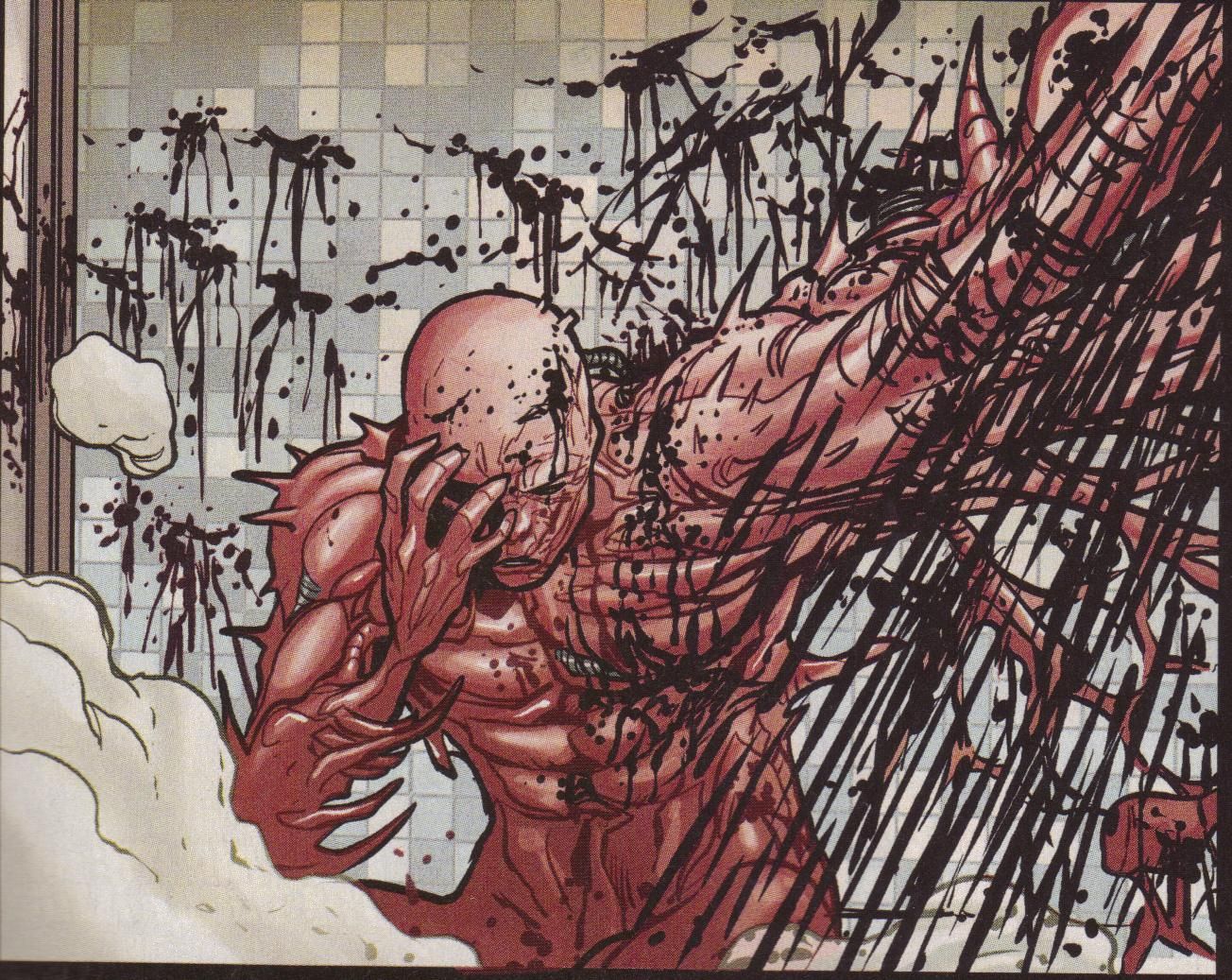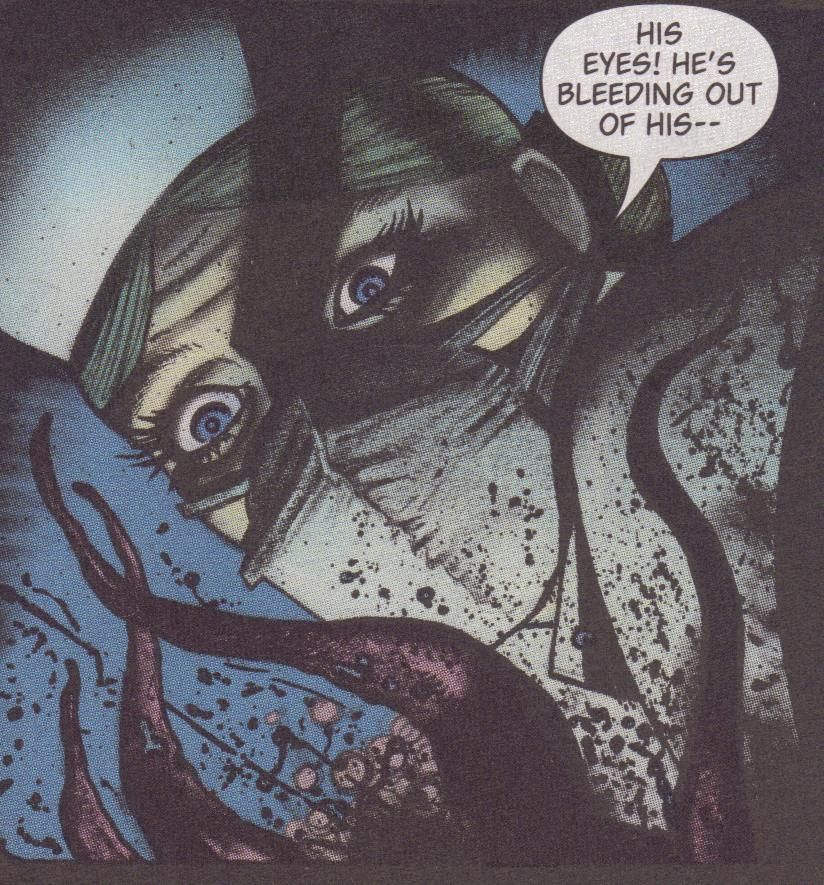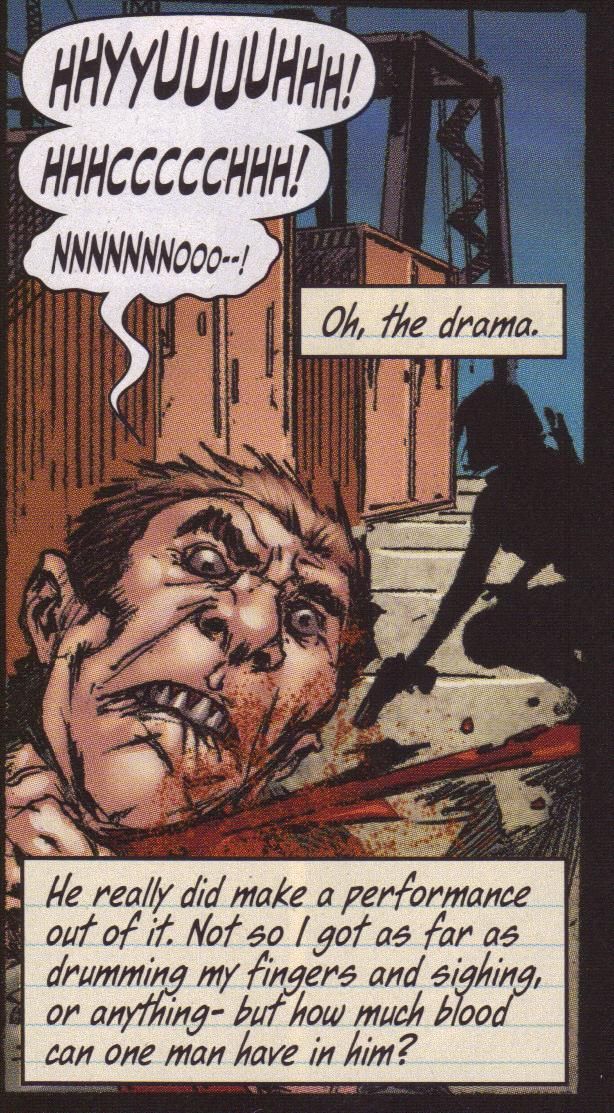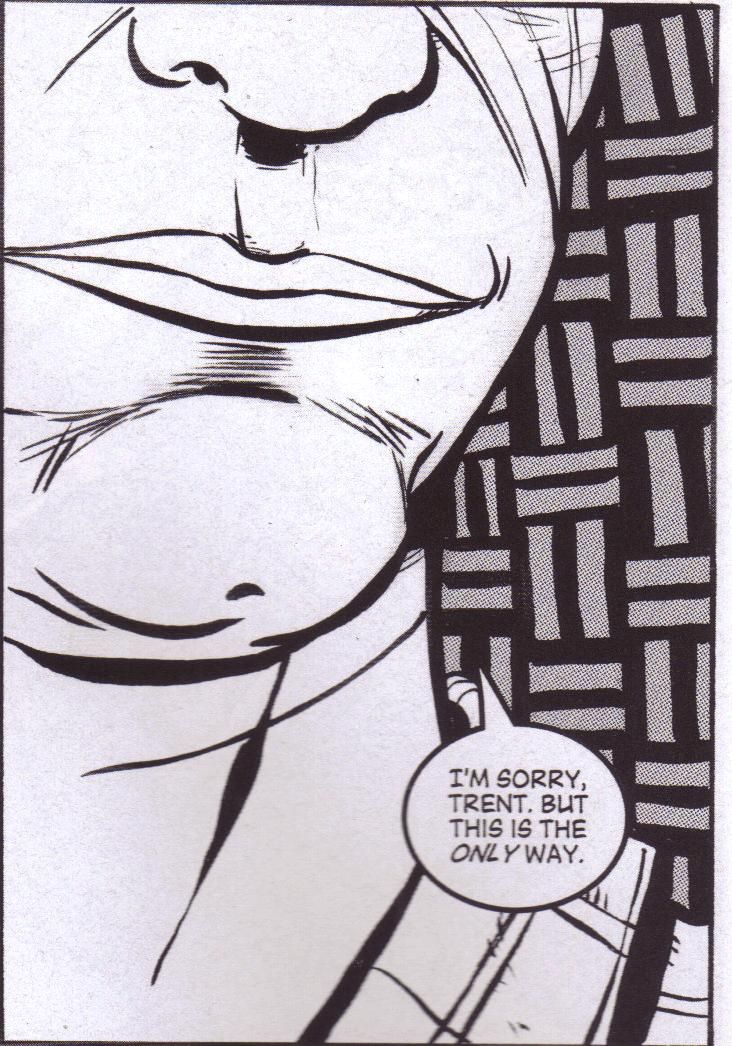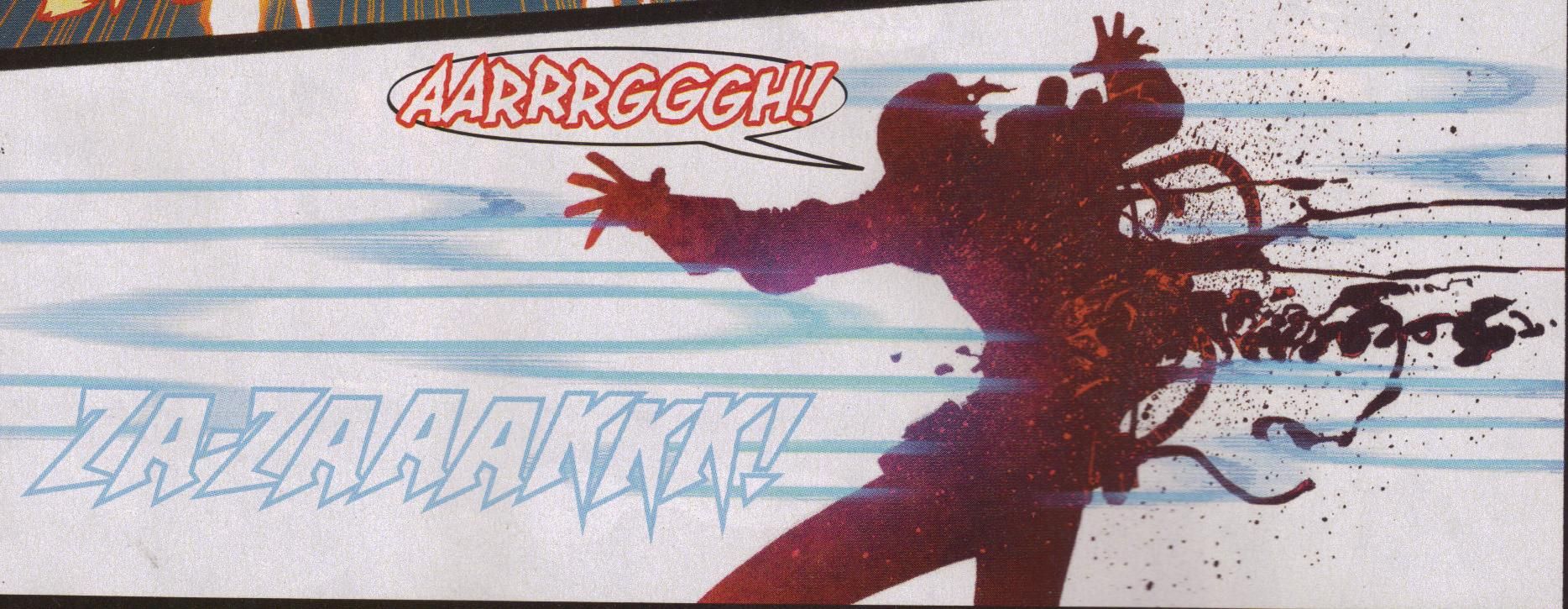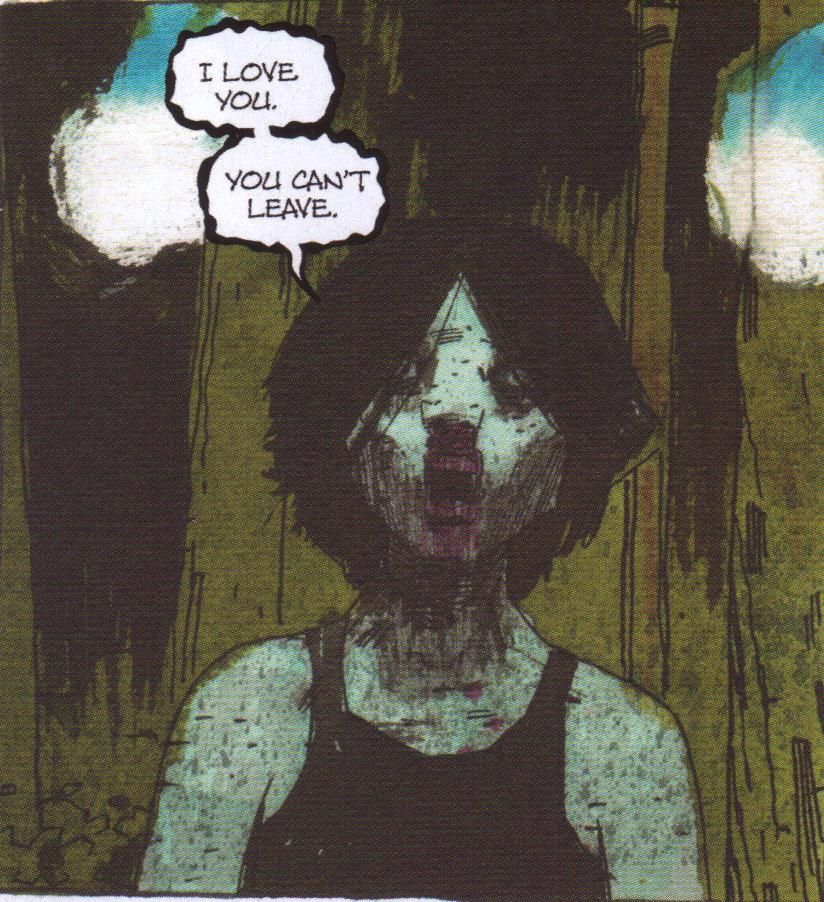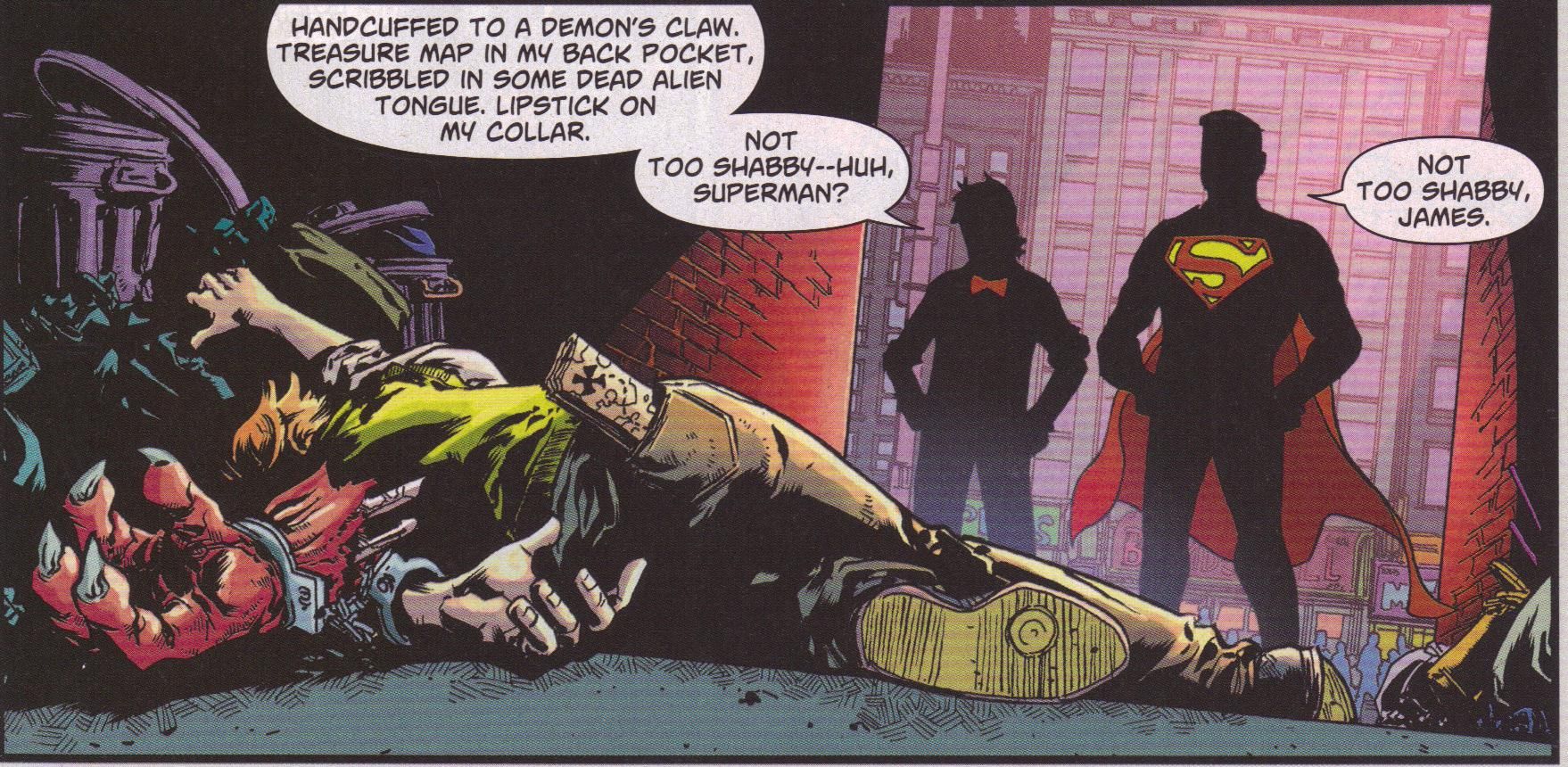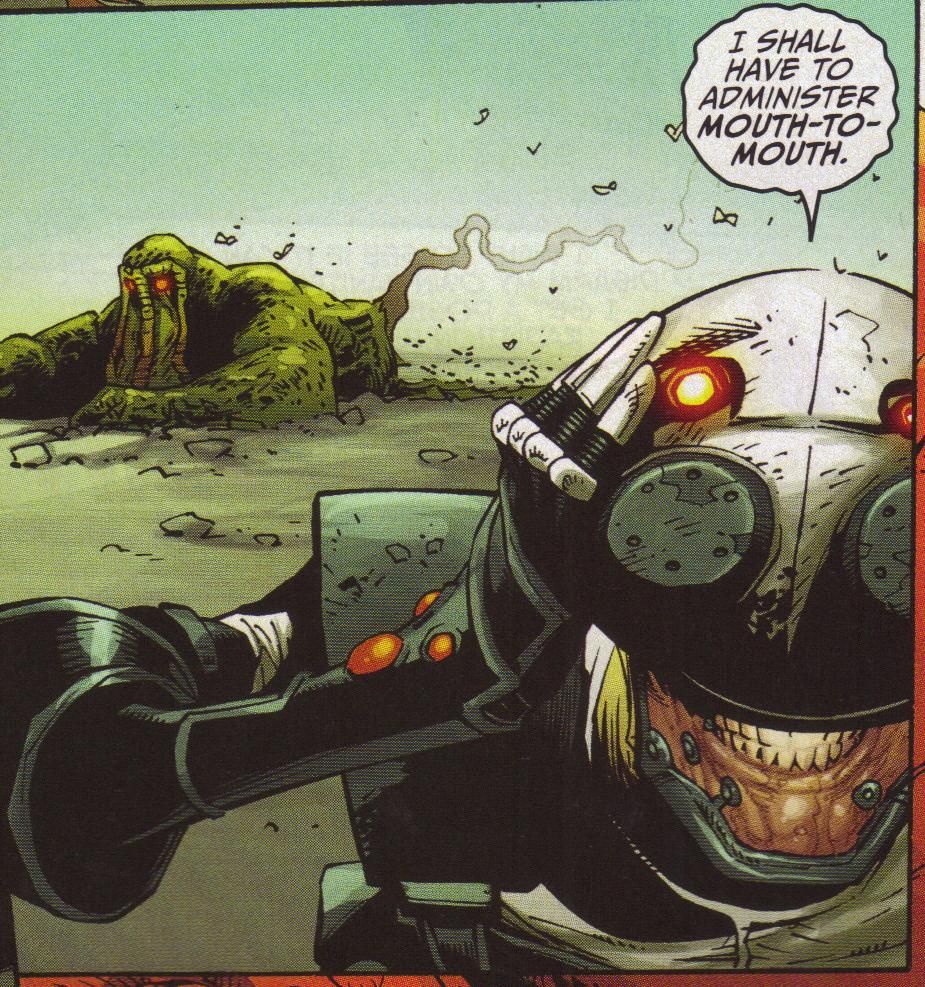She didn't realize that it was in the blood and not on the skin; she didn't see that there could be nothing more suburban than suburbanites repudiating themselves. (Hanif Kureishi, from The Buddha of Suburbia)
Avengers Academy #9 ("Teach Your Children") by Christos Gage (writer), Mike McKone (penciler), Rebecca Buchman (inker), Jeromy Cox (colorist), and Joe Caramagna (letterer). $2.99, 22 pgs, FC, Marvel.
Gage continues to write a very solid superhero comic with some interesting characters - he's working hard to make every character distinctive and memorable, and with a large cast like this plus older characters who already have accretions of personality built up, that's not easy. As we recall, last issue Tigra expelled Striker, Hazmat, and Veil from the academy for beating up the Hood and filming his apology. Of course, we could easily figure out that those characters weren't actually going to be expelled, but Gage does a nice job giving the actual Avengers reasons for not wanting Tigra to kick them out, and while they're similar reasons, he does well in showing why each character thinks that way and why Tigra herself believes they have ulterior motives. There's a lot of good dialogue in this section. Meanwhile, because this is a superhero book and sometimes you just have to show people punching each other, Finesse asks Quicksilver to help her find Taskmaster, as she believes he's her father. This leads to a well choreographed fight between Finesse and Taskmaster with a final revelation about everyone's favorite Marvel villain (isn't he yours?) that is logical but I'm not sure I've ever heard before. If it has been mentioned, that's fine that Gage brings it up, but if it Gage's idea, it's a good one. The final scene is perhaps a bit obvious, but Gage sells it well. The biggest problem with the dialogue in the issue is that Taskmaster rips off Bill Cosby (who of course may have been ripping someone else off), but if Cosby doesn't mind, why should I?
Avengers Academy really does have a charming, old-school feel to it, with solid soap opera and nice action. I don't want all my superhero books to read like this does, but it works here, and Gage straddles a nice line between Claremontian over-indulgence and Bendisian annoying realism in his dialogue, which works in superhero books. McKone (this is his last issue) and Raney (who's taking over for him) have a nice, clean, superheroic line which complements the script well. I know that Tim Callahan will be sure to pick up next issue, because Sean Chen is drawing it, but then Raney comes on after that. Who knows how long he'll last.
I don't think there's anything too, too great about Avengers Academy (it certainly could get there, but it's not yet), but if I get to indulge in some nostalgic yearnings for the "way superheroes were done in the 1980s" once a month, I don't see anything wrong with that!
Rating: ★ ★ ★ ★ ★ ★ ★ ½ ☆ ☆
One totally Airwolf panel:
Booster Gold #41 ("Booster-Busted!") by Keith Giffen (writer), J. M. DeMatteis (writer), Chris Batista (penciller), Rich Perrotta (letterer), Hi-Fi (colorist), and John J. Hill (letterer). $2.99, 20 pgs, FC, DC.
After last issue's retelling of Booster's origin to get new readers caught up, this issue deals with the repercussions of that issue - there's a Nazi doctor after Booster, and Rip Hunter just arrested our hero. First, Team Gold must deal with Dr. Nishtikeit, which seems easy but turns a bit harder than you might expect. It's a mild triumph for feminism that Michelle, who is told to take care of Rani, the girl Booster brought back from Daxam where her entire family was killed, joins the fray against the doctor because Rip Hunter gets injured and is relegated to the sidelines. I was wondering when Booster told his sister to take care of Rani why he didn't tell Rip - Michelle is a superhero, after all, and Rip isn't. So when Rip gets injured, I was glad that Giffen and DeMatteis didn't have him soldier on - he just tapped out, man!
Dr. Nishtikeit dispatched (but not captured, mind you), Booster must face his fate, and of course he's sentenced to five years in prison (which leads to the final page, where he gets a nasty new cell mate). I wrote this last month and the writers bring it up in this one - why now? Rip gives him some convoluted reason about him being a hero now so he won't run away if they throw the book at him, which is fine, but Giffen and DeMatteis want to get him into prison, and so they do, confound it! There's nothing really wrong with that, but the explanation does seem a bit forced.
And, of course, there's the fact that Dr. Nishtikeit wounds Booster, which will come back to haunt him. Good to see the sensible female is the only one concerned about the fact that Dr. Nishtikeit made vague threats about the wound before he escaped. I do wonder what Booster's suit is made out of, though - Nishtikeit spikes him in the back of the calf with a very sharp blade, and Booster doesn't even need a bandage? He's not limping? I would have thought severing or damaging the muscles in that area of the leg would at least make it very hard to walk, yet all he has is some pain, according to Rip. Weird. It's that 25th-century fabric, man!
Much like Avengers Academy, this is a solid superhero comic. I'm enjoying it. Maybe you would too!
Rating: ★ ★ ★ ★ ★ ★ ★ ½ ☆ ☆
One totally Airwolf panel:
Cyclops #4 (of eight) ("The Hero Part Two") by Matz (writer/translator), Luc Jacamon (artist), Edward Gauvin (translator), and Scott Newman (letterer). $3.95, 26 pgs, FC, Archaia.
I've been having a sinking feeling about Cyclops since issue #2, because I wonder if it's going to be just like a lot of other stories in this vein - the hero discovers bad things about who he's working for but he can't expose them because they have dirt on him that proves he's not as heroic as everyone thinks, but he decides to fight back and with the love of a good woman, triumphs over evil. You know what I just described? The plot of The Firm, among other things. And The Firm is very few people's idea of a good movie, although Holly Hunter kicks ass in it (and Tom Cruise bangs Karina Lombard, which makes him a total scumbag, of course, but then he desperately wants to get back together with Jeanne Tripplehorn for some inexplicable reason). Where was I? Oh, yes, John Grisham plots and how they relate to this comic. I mean, here we have Doug Pistoia, who has been turned into a hero by his bosses, the evil multinational corporation that runs a private army, and even though Doug seems to have bought in, he's troubled by certain things, and last issue he met a reporter who was also troubled by things, so they decided to be troubled together. I wrote that I hoped Doug wasn't going to sleep with the conniving female executive, and he didn't in that issue ... but he knocks boots with her quite a bit in this one, and I can just see some kind of evidence of this indiscretion winding up with his wife or at least being used to keep him in line. Oh, and the reporter has disappeared. Sigh.
So I'm jumping ship on this, right? Not so fast, my friend (yes, I just quoted Lee Corso - you have my permission to punch me if ever we meet - not the face!!!!). First of all, Jacamon is a good artist, so the book looks great. Second, I do have to pre-order these, so I've already done so for the next couple of issues, so why not see it through? Third, Matz is doing at least some interesting things with Doug - he has a freaky dream in this issue (see below) that seems to indicate there's something weird going on with him, and I'm just curious to find out what it is. It might lead to a bit of redemption with regard to the somewhat tired plot. Doug is having a crisis of conscience, but there's also something else a bit darker going on with him, and I wonder what it is. So there! Plus, I like the little details, like the fact that Doug still drinks the sponsor's beer even when he's not on camera, even though it's not very good. Is it drugged? Only time will tell!
On the whole, this is only slightly above average, and that's mainly because of the art. I'm disappointed by the series so far, because I think there are a lot of opportunities to satirize our love of advertising and reality television rather than going with the "fomenting wars just to make a buck" angle, but I'm also willing to see what happens in the second half of the series. Fingers crossed!
Rating: ★ ★ ★ ★ ★ ★ ☆ ☆ ☆ ☆
One totally Airwolf panel:
Doom Patrol #19 ("Suicidal Roulette Part Two: Ring-a-Ding Doom!") by Keith Giffen (writer), Matthew Clark (penciller), Ron Randall (penciller), Art Thibert (inker), Sean Parsons (inker), Guy Major (colorist), and Pat Brosseau (letterer). $2.99, 20 pgs, FC, DC.
As this is the second half of the crossover with Secret Six, I picked it up to see what happened and also to give Doom Patrol one more shot before it gets cancelled. Unfortunately, this is still a terrible, terrible comic book. I mean, really bad.
Let's start with the art, because I don't have too much of a problem with it, although it's nothing great. Matthew Clark is fine - he has an early-career Brandon Peterson vibe to him which I like but might not be your cup of tea. Randall is decent, too, although his art looks a bit rushed in this book. There's nothing awful about the drawing in this comic, although there's nothing wonderful either. However, I do find it very, very funny that Eric - the kid who decided to become a gangster in Secret Six and started this whole thing by hiring the Six to take out the Doom Patrol so he could have a lair inside a volcano - gains and then loses facial hair througout the course of the issue. He doesn't have it on one page, then a few pages later he has a cheesy goatee, then he's clean-shaven again. It appears that Randall draws him the first two times and Clark the third time (I certainly could be wrong about that), which would be even funnier. If the artists can't be bothered to pay attention to details like that, why should any readers give a crap about this comic?
Giffen's script is where the book really falls apart, however. This is really a lousy comic to read. I don't mind if writers don't write the best versions of characters that another writer has done really well with, but it's like Giffen has never read an issue of Secret Six, and if you're going to do a crossover, maybe you should pick up a few issues or at least give Gail Simone a call. Ambush Bug teleports Jeannette inside Danny the Hut (Danny the Hut? really?) and she freaks out (we don't see what happens to her). Now, I suppose that readers of this iteration of DP will know what horrible things Danny is capable of, but Jeannette has not really been someone who freaks out all that easily - she's kind of a tough bitch. I can understand if she does get scared eventually, but whatever freaks her out happens in one panel, which seems rather ridiculous. Later, when the Six are leaving Oolong Island, she whines to Bane that the sofa tried to eat her, and she still looks scared! I mean, yes, a sofa trying to eat you would be a bit distressing, but the Jeannette we know wouldn't fall apart quite so easily. Rag Doll, meanwhile, gets taken out by a pelican. Now, perhaps the pelicans on Oolong Island are super-birds, and it's a bit funny to see a pelican attacking Rag Doll, but again, he freaks out and screams for help. Rag Doll might get beaten up by a pelican, but he'd definitely make some kind of joke about it, not cry like a baby! Then, Cliff tells Rita see needs to divert the lava flow, and she says, a bit anxiously, "There's a lava flow!?" Well, Rita, considering that on the first page, you watched a volcano right near your location explode, didn't you consider it? I mean, I don't care if she didn't know about it, but the way it's written, it's as if she didn't even know a volcano had erupted anywhere near them!
I know this book has fans, but this is a terrible comic. It certainly lacks anything that made Grant Morrison's run brilliant, but it also lacks the crazy charm of the original run and even the earnestness of the Kupperberg run. It's just a poorly written, lazily drawn comic. Good riddance to it!
Rating: ★ ★ ★ ½ ☆ ☆ ☆ ☆ ☆ ☆
One totally Airwolf panel:
Fables #102 ("Super Team Chapter One: The Next Big Plan") by Bill Willingham (writer), Mark Buckingham (penciller), Steve Leialoha (inker), Lee Loughridge (colorist), and Todd Klein (letterer). $2.99, 20 pgs, FC, DC/Vertigo.
I have seen people complain about Willingham's conservatism before with regard to Fables (the Israel thing, most notably), but Willingham makes a very cogent point about the Fables in this issue, as Pinocchio, who is assembling a team of superheroes to go after the Dark Man, says that Fables themselves are a "traditional people." Willingham's conservatism may or may not have anything to do with your desire to read his comics, but it's interesting to consider that fairy tales are rather old and, even in their rawest forms, were designed to teach children lessons, mostly about staying home and out of trouble. So while you might not agree with the political subtext in Fables (whether there is a unified, underlying subtext or not is something you can debate), throughout the series we've seen good reasons why the Fables might act the way they do, and Pinocchio's statement is just the latest example of that.
There's a lot to like about this issue - Pinocchio is assembling a small force to go after the Dark Man, and he explains to Ozma why they should dress up like superheroes, which is perfectly plausible. Meanwhile, Beauty speaks for a lot of readers (well, this one, at least) when she rants about the Fables having a party before they had completely defeated the Dark Man, even though Beast has to step in and do some "mansplaining" to her about the situation (I still think Beauty is much more spot on than her husband, especially with regard to the way the Fables keep retreating). Basically, this issue catches us up on the principals - we see Nurse Spratt, for instance, and of course the end with the Dark Man is very effective - and sets things up for the new arc and the new direction of the book. It's a solid issue, and Buckingham, naturally, is wonderful. I do wonder what Bigby was doing in Nebraska, though ...
Rating: ★ ★ ★ ★ ★ ★ ★ ★ ☆ ☆
One totally Airwolf panel:
Generation Hope #4 ("The Future is a Four-Letter Word Part Four") by Kieron Gillen (writer), Salvador Espin (penciler), Scott Koblish (inker), Frank Martin (colorist), and Dave Sharpe (letterer). $2.99, 22 pgs, FC, Marvel.
Gillen finishes his first arc on this book, and it's a bit odd. The reasons I like Gillen's writing - the wit and incisive dialogue - are here, but at the same time, it feels as if Gillen is trying to write a long-form comic but needs to fit it into a trade paperback, so this issue is more of a transitional issue that is tacked onto the first arc because it needs to be four issues. Basically, this entire issue is about introducing Hope and the "lights" to Utopia, figuring out what their powers are (finally!) and wrapping up whether Kenji is a bad guy or not. It feels like Gillen wrote the final scene simply to provide some kind of cut-off point for the trade, where if this were a comic from the 1980s, the fuse would be longer. I may not be making any sense, but it's mostly to do with pacing - after a few issues of fast pacing, this issue slams on the brakes, and not really in a way that feels natural. It's odd.
But it's an intriguing series so far, and I'm glad that Gillen does give us more about the characters and what they can do. He began the series with Kenji being weird, so it's only fitting that he ends the arc by focusing on Kenji and what he can do. Gillen can write really good dialogue, so the fact that this issue is a bit of a breather doesn't bug me too much, even though it's a bit off. I hope that now that he's gotten the first introductory arc out of the way, the book can settle down a bit. I think the fact that it didn't really start with issue #1 but followed the Hope stuff that I didn't read has thrown this entire arc a bit out of whack. No matter - we've gotten everyone onto the team, and we'll go from here.
I do question the end, though. Is that blood (see below)? If it is, ew. But why so much blood from such a small wound? And if it is blood, Marvel should suck it up and make it red. It's idiotic to confuse readers just because you fear some kid will get his mind warped by seeing red blood. Kids get scratches all the time - they know that blood is red! If it isn't blood, what the flying fuck is it? Are we not supposed to know what it is and it will be answered in good time? Is it oil because Kenji is part machine? It's a cool scene, but it was a bit weird. Yes, these things bother me!!!!
Rating: ★ ★ ★ ★ ★ ★ ★ ½ ☆ ☆
One totally Airwolf panel:
Hellblazer #276 ("High-Frequency Man") by Peter Milligan (writer), Simon Bisley (artist), Brian Buccellato (colorist), and Sal Cipriano (letterer). $2.99, 22 pgs, FC, DC/Vertigo.
Milligan takes a bit of a break before launching into the next arc, with a one-and-done issue (so we think!) about John having some fun with the developer who wants to buy up the area in Brixton where he (John, that is) lives. It's a bit of a return of the Bastard John who had taken a back seat while Nice Guy John got married, and it's interesting because Milligan shows us that he hasn't really forgotten what a tool John can be. We're invited to laugh along as a douchebag gets what's coming to him, but what's interesting about the issue is that the douchebag doesn't do anything particularly heinous - I mean, yes, he's a douchebag for buying up land and evicting the tenants, but he's not doing anything blatantly illegal or even that terribly evil - if being a douchebag was against the law, John himself would have been executed long ago - but that Epiphany herself doesn't want to live in Brixton, or at least not in John's stinky old flat, so John goes after the douchebag simply because, it seems, he doesn't like douchebags. John is particularly immature in this issue, which isn't too bad a thing for him to be after several issues where he seemed to be growing up a bit. Milligan just wants to remind us that even if he's grown up a bit, underneath it all is a frightened, petulant child who likes pulling the wings off of flies. It's a good dichotomy, and I'm glad Milligan brought it back.
Oh, and Bisley's pretty good, too. Duh.
Rating: ★ ★ ★ ★ ★ ★ ★ ★ ½ ☆
One totally Airwolf panel:
Jennifer Blood #1 (of ?) ("War Journal") by Garth Ennis (writer), Adriano Batista (artist), Romulo Fajardo Jr. (colorist), and Rob Steen (letterer). $3.99, 22 pgs, FC, Dynamite Entertainment.
And now, Garth Ennis and Me: A Love Story.
Ten years ago, I would have said Garth Ennis was my second-favorite comic book writer (after the God of All Comics). The 1990s were very good for Ennis - he had written three absolutely wonderful stories in three different kinds of formats, and when he moved to Marvel, he redefined the character of Nick Fury (not the real one, God forbid, because Jemas and Quesada weren't quite that hip) in brutal fashion. All was well in Ennis-land.
Then, something happened. I'm still not sure what it is. His long run on The Punisher, which more than a few people here at yonder blog swear is pure genius, just isn't. Granted, I haven't read it all, but I've read enough to know that while they might be above-average Punisher stories, that's about it. I mean, Return to Big Nothing is an above-average Punisher story and you don't see people getting all weepy about that, do you? Then Ennis started The Boys, another comic that certain people love. I've read less of it than The Punisher, but those first six issues - before DC ditched it - are horrible comics. It's not that I'm offended by the violence or sex, it's that I'm offended by the sheer awfulness of the issues - they're disgusting, mean-spirited, absolutely joyless, sexist, dumb, poorly written and even poorly drawn - Darick Robertson's art can't even save them! So I don't care if the series has gotten better (and from the brief times I've looked at an issue, I can't really believe it), because after those first six issues, it couldn't get a whole lot worse. And so my love for Ennis weakened even more. My theory is not that he hates superheroes, as is famously bandied about, because he writes superheroes so darned well (he wrote one of the ten best Superman stories ever, after all). My theory is that he's mad because he wants to write DC and Marvel superheroes in a puerile fashion, but they won't let him, so he vents against those companies - not superheroes - in The Boys. Let's face it, if someone hated superheroes as much as Ennis supposedly does, they would simply never write anything about superheroes again. Yet he's been obsessed with superheroes for five years in one series now.
My love for Ennis is in the distant past now, tainted by what I think is a guy who is largely one-note and thinks the way to mask that is to become more and more depraved in his writing. The only glimmers of hope I get from Ennis these days is his war comics - "Dear Billy" was a marvelous story, for instance - which are more horrifying with their violence because it's in a more realistic setting and also more devastatingly honest in their emotional impact. It makes me realize that maybe he's not one-note, but for some reason, his dominant note is all that he's willing to commit fully to. It depresses me, because when Ennis is on, he's really on. And it's not even like he's mailing it in - he's defiantly committed to The Boys even to the point that he refused to bow down to DC over it. That makes his commitment to, well, shitty comics all the more vexing.
Which brings me to Jennifer Blood, Ennis's new mini-series. Despite a decade of being mostly disappointed in Ennis comics, I will still try things he writes - Crossed sounded so vile I didn't want to, but I've tried others - and Jennifer Blood is one of those. The set-up sounds typically Ennis-stupid - a housewife goes out at night as a vigilante - but it could be fun, and indeed, in the backmatter Ennis speaks of wanting to have some fun. So yes, as dumb as the idea is, Ennis can make the weird dichotomy between the bored housewife and the kick-ass killer (she's stalking five men for some reason which we'll discover later) work, but will he?
Sadly, no. This is a pretty lousy comic book, and although I''ve already pre-ordered issue #2, if I didn't have to do that a few months in advance, I would drop the book right now. I'm done giving Ennis any rope - issue #1 better be excellent, man! Actually, even if this was decent, I might have stuck with it, but it's not. The biggest problem is that Ennis is writing a first-person narrative ... and that person is a woman. There's nothing wrong with the opposite gender writing a first-person account, but it is, I think, harder than just writing a third-person account (I don't know; I've never written a first-person narrative where the narrator is a woman), and therefore the writer really needs to pay attention to details, and Ennis just doesn't. This doesn't sound remotely like a woman, it sounds like a man trying really hard to write a woman but getting it wrong. It's not just bad writing - although there's plenty of that - it's little things, like Jennifer saying she got a manicure ... but only the toes. Most men, I would imagine, would know the difference between a manicure and a pedicure, and I can't even imagine a suburban mother like Jennifer not knowing the difference. Sheesh. The first page shows Jennifer's diary, and it looks like something a 13-year-old with a crush on Justin Bieber would write in. Really, Ennis (or Batista - I don't know who actually designed the diary)? It's just dumb. When you consider that this is a really, really wordy issue, and most of the words don't ring true, it becomes very problematic. This feels like a rather low-aiming satire of suburban life, from the doofus of a husband who wakes up in the middle of the night just to fuck his wife (didn't she drug him?) while she stares at the ceiling, bored out of her mind, to the white trash mechanic who gropes his receptionist in front of Jennifer. None of it is inventive or clever or interesting in the least, and the only saving grace of the issue is that Jennifer shuts up a little when she starts killing, and Ennis does a nice job showing that Jennifer is much more interested in slaughter than anything else - she's focused and terse, and Ennis has always been good at describing slaughter, so this part of the book, while not great, is a welcome relief from whatever Ennis is trying to do with Jennifer at home. That part of the book, frankly, stinks.
Batista does absolutely nothing to help. I know Dynamite has a house style to a certain degree and Batista fits that, which is why he's working for them, but this is kind of amateurish art, with rough, stiff figures, stereotypical character design, and very little flow. Some of the violent scenes are okay, but nothing great. Ennis has worked with good artists at Dynamite before - he obviously has some pull - and it would have been nice if he could have gotten a better artist on this book. It wouldn't have helped too much, but it would have made the crappy script a bit easier to deal with.
So my love of Garth Ennis continues to fade. It's kind of sad. I'm on the hook for issue #2, so I still hold out hope that this will get better, but it's not a lot of hope. We shall see.
Rating: ★ ★ ★ ★ ☆ ☆ ☆ ☆ ☆ ☆
One totally Airwolf panel:
Memoir #2 (of 6) by Ben McCool (writer), Nikki Cook (artist), and Tom B. Long (letterer). $3.50, 22 pgs, BW, Image.
As usual with mini-series, it's kind of hard to judge this because McCool is definitely writing this as a whole separated into chapters. There are some annoying parts of this issue - a little of the mysterious villagers goes a long way, and is that a fat, somewhat vile FBI agent? - but I like the silhouettes pointing all over the place, and although it's a cliché, Trent getting a surprise when he listens to the recording he made was effective. Cook remains the biggest reason to check this out, because her odd art fits the creepy tone perfectly. That's not to say McCool's story isn't intriguing and won't go anywhere, but after two issues, it's kind of hard to figure it out. But I'm patient!
Rating: ★ ★ ★ ★ ★ ★ ½ ☆ ☆ ☆
One totally Airwolf panel:
S.H.I.E.L.D. #6 ("The Master's Hand") by Jonathan Hickman (writer), Dustin Weaver (artist), Christina Strain (colorist), and Todd Klein (letterer). $2.99, 22 pgs, FC, Marvel.
The first volume of S.H.I.E.L.D. comes to an end in much the same way each issue does - somewhat ambiguously. Hickman obviously wants the final panel to resonate, and while Leonid's attempts to stop the war between Isaac Newton and Leonardo da Vinci is kind of cool, the final panel will only resonate retroactively, when we find out what happens next. That's an odd way to end this volume, especially as S.H.I.E.L.D. will be on hiatus for quite some time (the next issue hasn't been solicited yet, with a placeholder issue coming out in May that will flesh things out somehow without dealing with the main narrative, apparently). Meanwhile, Howard Stark, Nathaniel Richards, and Nikola Tesla manage to make it back from the future, and we learn a bit about their past. The frustrating thing about S.H.I.E.L.D. is not that this arc really doesn't resolve a whole hell of a lot or even tell that much of a story, it's that the book comes out so slowly that being patient is a chore. I love the utter wackiness of Hickman's story even as he writes for six issues to make the point that war sucks, and I love looking at Weaver's art, but I've quickly resigned myself to the fact that I might not get much for a long time, both in which issue number it will be and when that issue will come out. I enjoy each issue of S.H.I.E.L.D. simply for the small moments - Leonid's wall blasting upward from the Immortal City, the comaraderie between Richards and Stark, the wild designs of Weaver, Michelangelo's cryptic speech - without worrying too much that Hickman is taking his own sweet time with it. I can be patient. I can, damn it!!!!
Rating: ★ ★ ★ ★ ★ ★ ★ ★ ☆ ☆
One totally Airwolf panel:
The Suicide Forest #3 (of 4) by El Torres (writer), Gabriel Hernandez (artist), and Malaka Studio (letterer). $3.99, 22 pgs, FC, IDW.
I don't like The Suicide Forest quite as much as The Veil, the last collaboration between these two creators, but I'm still enjoying it and, as with most horror, a lot depends on the end. Torres is trafficking a bit too much in stock horror clichés in this series - in this issue, it's time for the culling of the extraneous herd! But the end is quite good, even though we knew Ryoko's father would show up at some point - his appearance is effective and bit more devastating than you might expect. Hernandez does a nice job with the three full page drawings of the herd-culling, and the ghosts at the end are very cool. Hernandez has done some work for Marvel recently (including on that Age of X thing that Chad and Kelly reviewed), but I can't believe he works very well in the bright-and-shiny superhero universe, because he's so good on creepy stuff like this. So far, the art on The Suicide Forest has outpaced the story to a degree, but it's still an entertaining read.
Rating: ★ ★ ★ ★ ★ ★ ★ ☆ ☆ ☆
One totally Airwolf panel:
Superman 80-Page Giant 2011. "First Time for Everything" by Beau Tidwell (writer), CAFU (penciller/inker), Bit (inker), Santiago Arcas (colorist), and Sal Cipriano (letterer); "Old Men Talking in Bars" by Neil Kleid (writer), Dean Haspiel (artist), Joe Infurnari (colorist), and John J. Hill (letterer); "Quarter-Life Crisis of Infinited Jimmy Olsens" by Abhay Khosla (writer), Andy McDonald (artist), Chris Beckett (colorist), and Sal Cipriano (letterer); "No Go Away Glad, Just Go Away!" by Steve Horton (writer), Dan McDaid (artist), and Patrick Brosseau (letterer); "The Bloodsucker's Moxie" by Joe Caramagna (writer), Trevor McCarthy (artist), Andre Szymanowicz (colorist), and Patrick Brosseau (letterer); "Credit Check" by Paul Tobin (writer), Colleen Coover (writer), Amilcar Pinna (artist), Chris Beckett (colorist), and Travis Lanham (letterer); "Bad Moon Rising" by Aubrey Sitterson (writer), Eddy Barrows (penciller), JP Mayer (inker), Rod Reis (colorist), and John J. Hill (letterer). $5.99, 70 pgs, FC, DC.
This came out two weeks ago, but it never showed up at my shoppe, and I forgot to ask about it. Then Tim Callahan, who is often mistaken about things (he honestly thinks that Mark Bagley is one of the worst artists out there, to the point where he thinks Brett Booth is better than Bagley, which just makes me shake my head sadly), said that Abhay's Jimmy Olsen story is not only good, it's the best Jimmy Olsen story ever written and deserves awards when such awards are given out, so I had to track it down. So is Tim right, or has his hatred of Mark Bagley clouded his judgment so much that he'll praise bad stories and watch a reality show starring Snooki and The Situation? (Come on, you can totally see Callahan DVRing Jersey Shore and thinking about how he could write a critical analysis of it for Sequart. You know it's true!!!!!) Well, we shall see, shan't we?
If we check out the other stories first, they're a mixed bag, not surprisingly. Tidwell's story about Jor-El looks great thanks to the art team, but it's kind of treading extremely familiar ground and basically does nothing except establish Jor-El as an action star. I mean, the story is about how Jor-El believes Krypton isn't a great place to live anymore and his quest for proof. I wonder how that works out? Kleid and Haspiel's story of Perry White chatting with Ted Grant in a bar is decent enough, with Haspiel's art looking odd yet somehow right in a sort-of superhero story, while Kleid lays the nostalgia on thick. I always wonder in comics, which are ridiculously sentimental even if the creators ostensibly are not, how much the creators are putting themselves into the characters or if they really do think the characters act this way. I've never been much on "embracing my roots," so perhaps these kinds of stories don't resonate with me, but I do wonder if writers feel this way or if they just think characters in superhero comics are already conservative and traditional, so they might as well make it blatant. But the story zips along, and I don't really have anything bad to say about it. The Bizarro story is by a pretty good margin the worst story in the anthology, even though Dan McDaid does a nice job illustrating it. I don't have a lot of love for Bizarro, so a Bizarro story has to be really good to make me care, but this is just Bizarro flying around Bizarro-World talking to Bizarro-analogs of the DCU, and it's even more pointless than most short stories in anthologies are. Tidwell's Jor-El story, for all that it is pretty obvious, at least adds a tiny bit to the Superman mythology. The Bizarro story is just an excuse for all the characters to do that idiotic Bizarro speech that is not really simply the opposite of what they're saying, so it never quite works as well as people think it does. God, I hate Bizarro.
The Supergirl story is a bit odd for a few reasons. Trevor McCarthy's art is pretty good, although in a few panels, Kara/Linda's mouth is drawn so bizarrely that it's almost mangafied, even though the art looks nothing like manga. Linda has bigger breasts than Supergirl, too, which is kind of weird. I only notice because Linda is drawn with rather large breasts but it doesn't look gratuitous, which is a tough trick to pull off, and then when she changes costume, it actually looks like her breasts are smaller. Wha ... huh? Finally, she goes to a regular earth carnival and in the freak show tent, there's a horrible alien monster just hanging out in a jar? And she knows how terrible it is, but she allows her pseudo-boyfriend to steer her away so that douchebag guy who took her into the freak show can release it? And I assume the douchebag is killed, but nobody seems to bothered by that. Shouldn't someone express a tiny bit of remorse - "Oh, poor douchebag - he was a dick, but nobody deserves to die that way!" Strange. (I've used "douchebag" a lot in this post - this is the final mention of it, I promise!) The Lois Lane story involves her finding a debit card on the street and, instead of returning it to the bank like she wants to, allowing Lana to goad her into finding the dude who dropped it herself. Which of course leads into a whole world of danger! It's not a bad story, although it is wildly far-fetched, but I wonder, if Coover is the co-writer, why she wouldn't draw the damned thing herself. Pinna's art isn't terrible, but it's not as good as Coover's. She couldn't knock out a ten-page story at some point in the past six months? Finally, Superboy gets all dickish with Ma Kent (because he doesn't want to learn about the Byzantine Empire, which has more sex and violence in its history than even Jersey Shore - what do you think of that, Callahan?), flies around for a while, and beats on a werewolf. It's okay, and Eddy Barrows doesn't suck on art, so there you go.
What of the Jimmy Olsen story, though? Well, it's certainly not as good as the wise Mr. Callahan would have you believe, but it's the best story in the collection. Andy MacDonald's art is fantastic - I've seen his name here and there but have never seen his art, and it's really good. It's quirky without being silly, and his smallish Superman is oddly tragic. He has a nice sense of layouts - the brief romance is twelve small panels placed on the upper third of a page, capturing the beautiful moments of any relationship - and strong design work. Abhay's story is nicely done with some problems. It's far too obvious, for one, which doesn't necessarily make it bad, because some excellent stories are obvious, but this has two obvious conclusions, so that makes it a bit more egregious. The story's conclusion is a bit forced as well, because it doesn't seem to apply to Jimmy Olsen. Superman is strangely detached, too - isn't he Jimmy Olsen's pal? I suppose he speaks to Jimmy in that manner to hammer home the story's conclusion, but that doesn't mean it's not annoying. And while it's fun to see clones of Jimmy Olsen doing all sorts of wacky things, the fact that this all takes place over the course of one single day makes some of the situations into which the clones get just a bit silly. Abhay doesn't want to just write a silly story, but that's what it is, and that's why the ending feels a bit out of whack. It's a fun tale, and Abhay tries to do something different, which goes a long way, so the fact that he doesn't quite pull it off doesn't get me too bent out of shape. But it doesn't mean that the story deserves an award.
This is six dollars, and it's an impressive package. If you see it around, you might want to check it out, because it's always cool when DC or Marvel lets some oddball creators work some magic on their top tier characters. You could buy two shitty issues of the regular Superman series, or you could just get this!
Rating: ★ ★ ★ ★ ★ ★ ½ ☆ ☆ ☆
One totally Airwolf panel:
Thunderbolts #153 by Jeff Parker (writer), Kev Walker (penciler), Jason Gorder (inker), Frank Martin (colorist), and Albert Deschesne (letterer). $2.99, 22 pgs, FC, Marvel.
It's a fairly rare occurrence to see a decent Greg Land cover, so I thought I'd point it out. Well done!
Last issue, the Thunderbolts enlisted Hyperion to help them beat up giant monsters that were approaching Tokyo. They thought it was a good Hyperion from one of the alternate Marvel universes. Yeah, they thought wrong. So last issue, Hyperion took a bunch of them down, and in this issue, they fight back. It's all very simple and believable! (Quick quiz: Identify that quote!)
There's not a lot to say about this issue, except that Parker checks in on Gunna, who's been chillaxing on the Raft for a few issues, and Ghost gets to do something icky (see below). Other than that, it's mainly Walker's show, and he doesn't disappoint - Hyperion going toe-to-toe with Juggernaut while the rest of the team gets themselves together is a fight to behold. It's really a well done fight, and they stop the monsters to boot! Yay, T-Bolts! All's well that ends well, I suppose - there didn't seem to be much point to this story except Parker wanted to have monsters attack Japan and, I suppose, it brings the team slightly closer together. That's pretty swell. But it's still a very good superhero two-parter, mainly because it looks so danged good.
As Man-Thing is in this comic, I suppose I should ask a question about him. So what's his deal? Why do you burn if you fear and he touches you? I'm not really up on my Man-Thing history, so has that very odd "power" ever been explained? And why does he go around touching people, anyway? Is he drawn to fear for some reason and must touch those people? Does it provide sustenance for him? I suppose I could look all this shit up on the Internet, but you people are my Internet! Enlighten me!
So I've gotten four straight issues of Thunderbolts. It's pretty good. I'll have to keep buying it!
Rating: ★ ★ ★ ★ ★ ★ ★ ☆ ☆ ☆
One totally Airwolf panel:
Finder: Voice by Carla Speed McNeil (writer/artist). $19.99, 215 pgs, BW, Dark Horse.
I have mentioned this before and I'll mention it again now: In the past, I haven't been too impressed with Finder. However, the trade that McNeil gave to me last year in San Diego was pretty good, and this is a brand-new story to celebrate her move to Dark Horse, so I'll give it a chance. In case you're wondering - yes, it's annotated. You may or may not enjoy that.
Noche Roja by Simon Oliver (writer), Jason Latour (artist), and Clem Robins (letterer). $19.99, 180 pgs, BW, DC/Vertigo.
Jason Latour continues to show us what he's been doing for the past few years (stockpiling pages and pages of art, apparently), as we get the latest Vertigo Crime novel. It claims to be about the murders around Juarez, but who knows if that's just a MacGuffin. I'll let you know.
Here we are, at The Ten Most Recent Songs Played On My iPod (Which Is Always On Shuffle):
1. "I Thought You Were my Boyfriend" - Magnetic Fields (2004) "I just hope you're happy stringing me along"
2. "Poets and Slaves" - Midnight Oil (2002) "You're gonna crash like the waves, you can't remember your name"
3. "She Gives Me Love" - Godfathers (1989) "She's the kind of a girl that if you gave her the world, she'd say it wasn't worth a dime"
4. "Come on Home" - Indigo Girls (2004) "There's a bag of silver for a box of nails; it's so simple, the betrayal"
5. "Don't Kill" - Hamell on Trial (2003) "I'm God, why don't you hear me - I've been saying the same shit for centuries"
6. "Rusty Cage" - Soundgarden (1991) "You wired me awake and hit me with a hand of broken nails"
7. "Broken Hearts" - Living Colour (1988) "I see the reason for things I used to do; they're all transparent now and so I see the truth"
8. "Secrets" - Van Halen (1982) "The question is not, Does love exist? but when she leaves, where she goes?"
9. "Strange Relationship" - Prince (1987) "I bet you wish this was a movie, then you could rewrite my every line"
10. "Gold" - Prince (1995) "What's the use of being young if you ain't gonna get old?"
How about we see what's what in Totally Random Movie Quotes?
"I guess it's just one of those ex-felon, pro-acid kind of non-smoking homes."
That's all you get! But damn, what a funny-ass movie that is!
If anyone has noticed the tweaks to our blog, I haven't seen any comments about it. I don't mind knowing who's tweeting about us even though I don't use Twitter and will resist using Twitter like my mom resists DVR/TiVo (I don't get it - it's so cool and you can fast forward through commercials!!!!!), but I miss tags. What happened to my tags? I asked Our Dread Lord and Master about it, but he's been busy. Does anyone else miss tags? Let your voices be heard!!!!!

